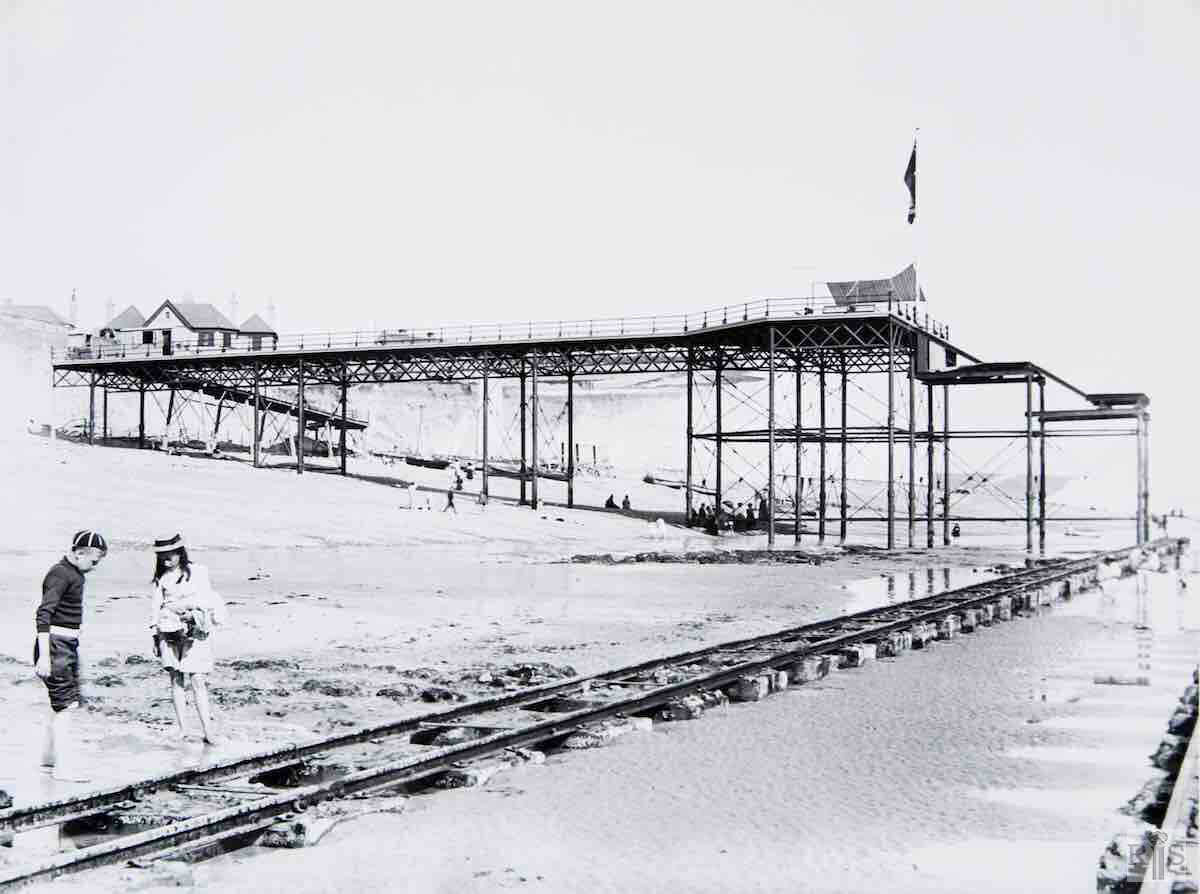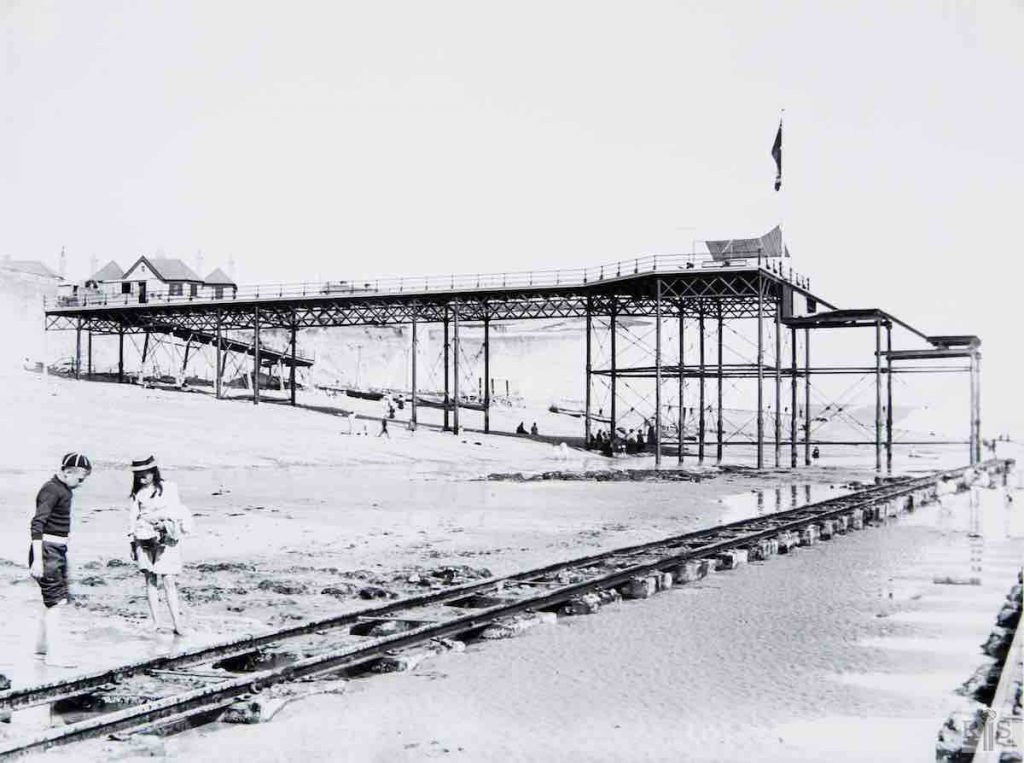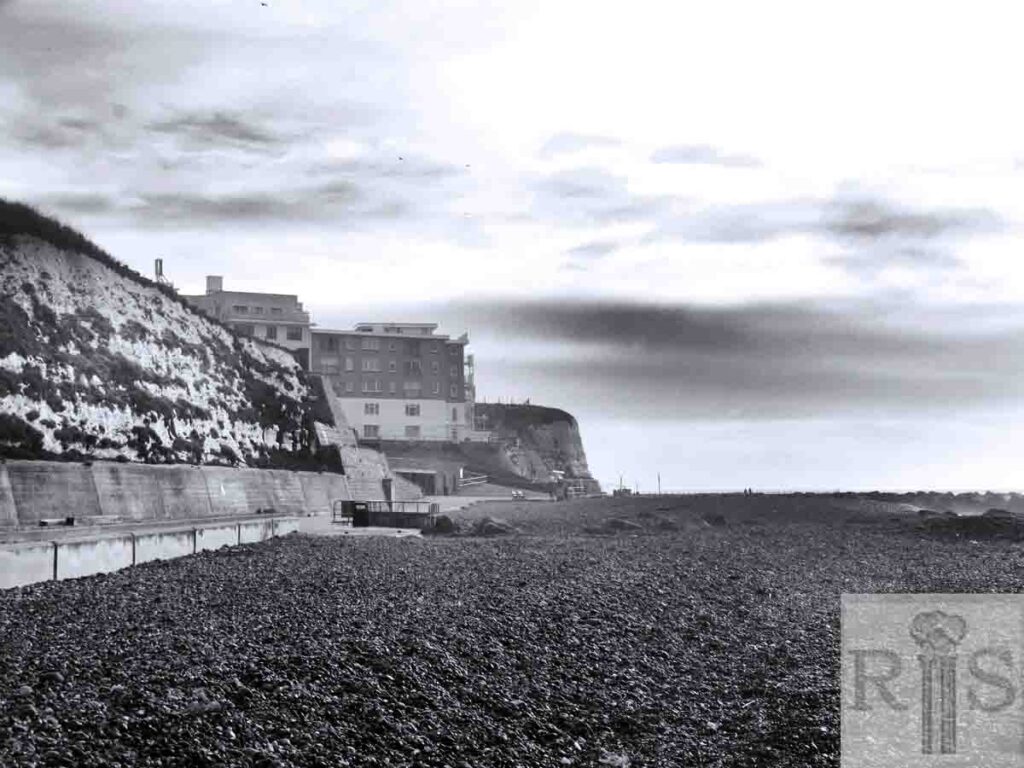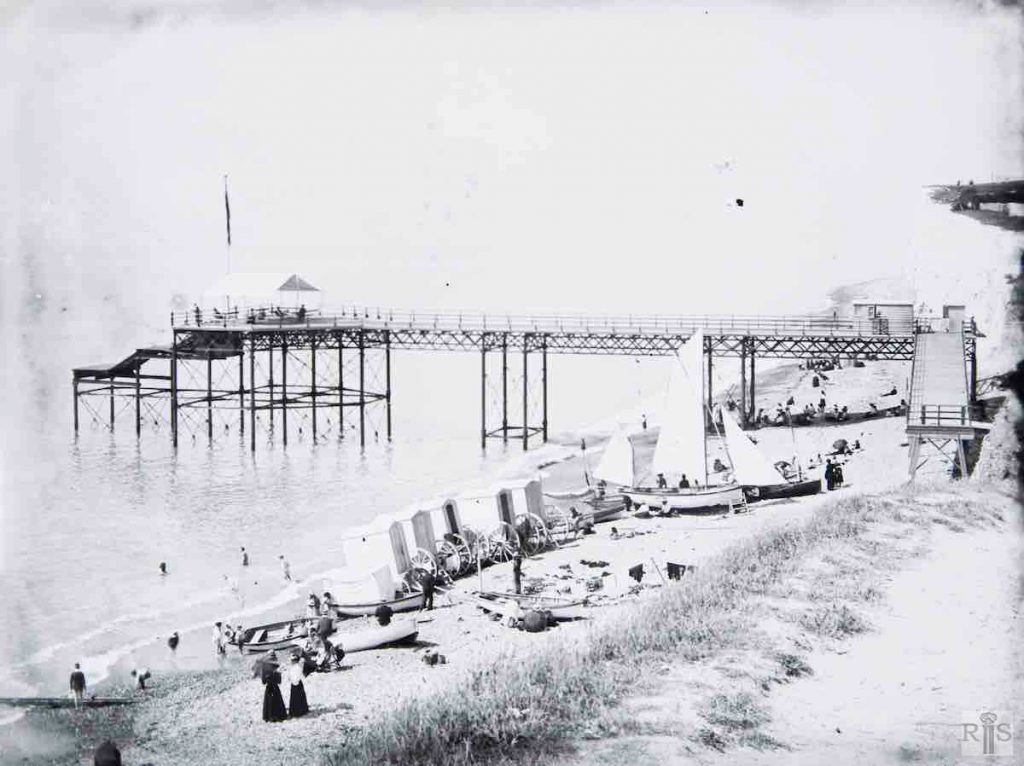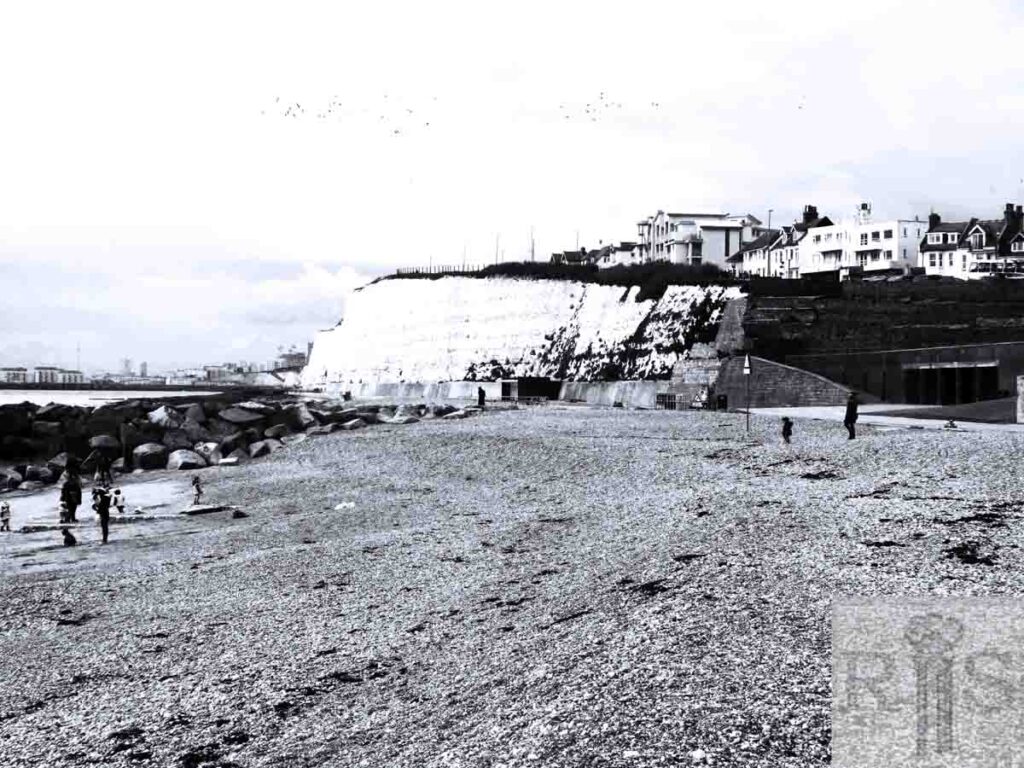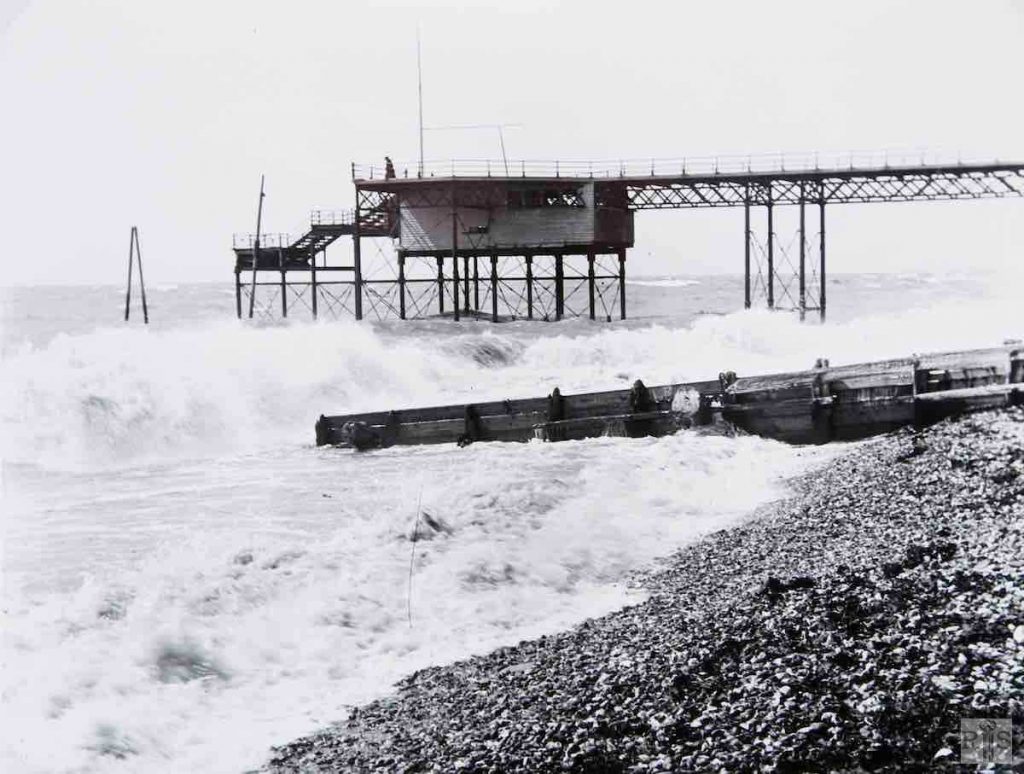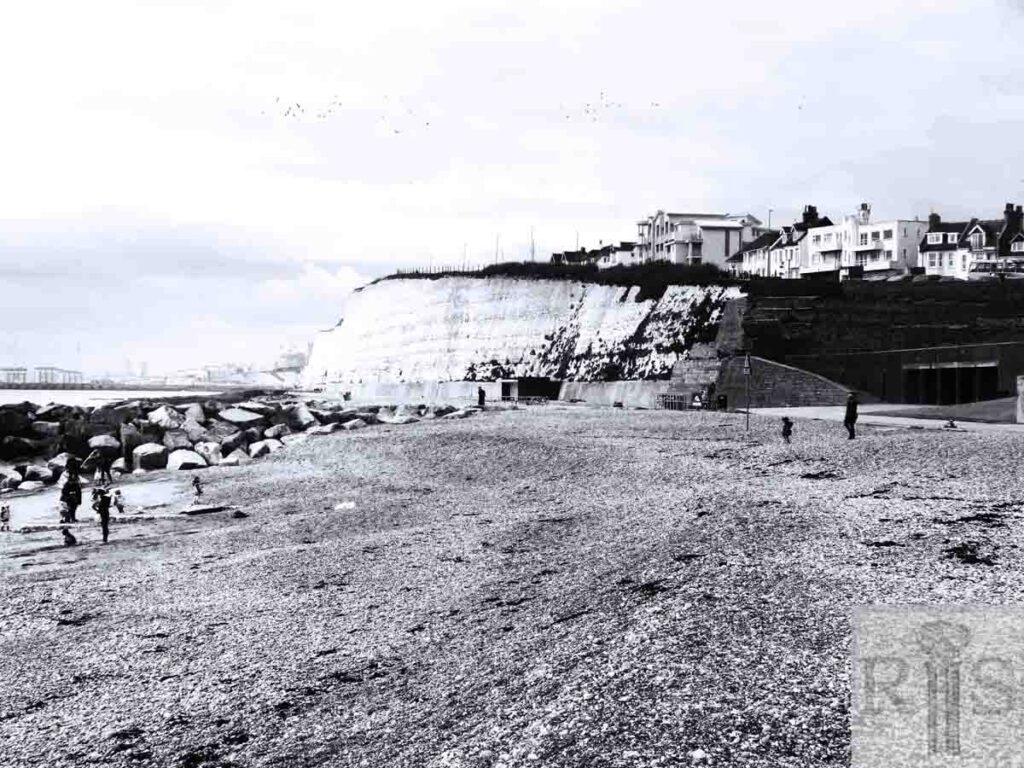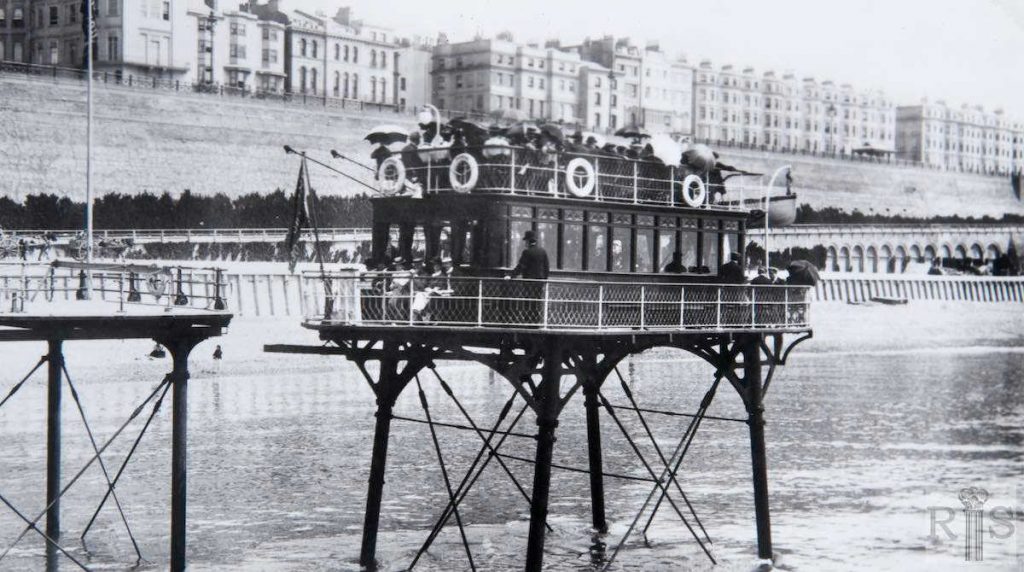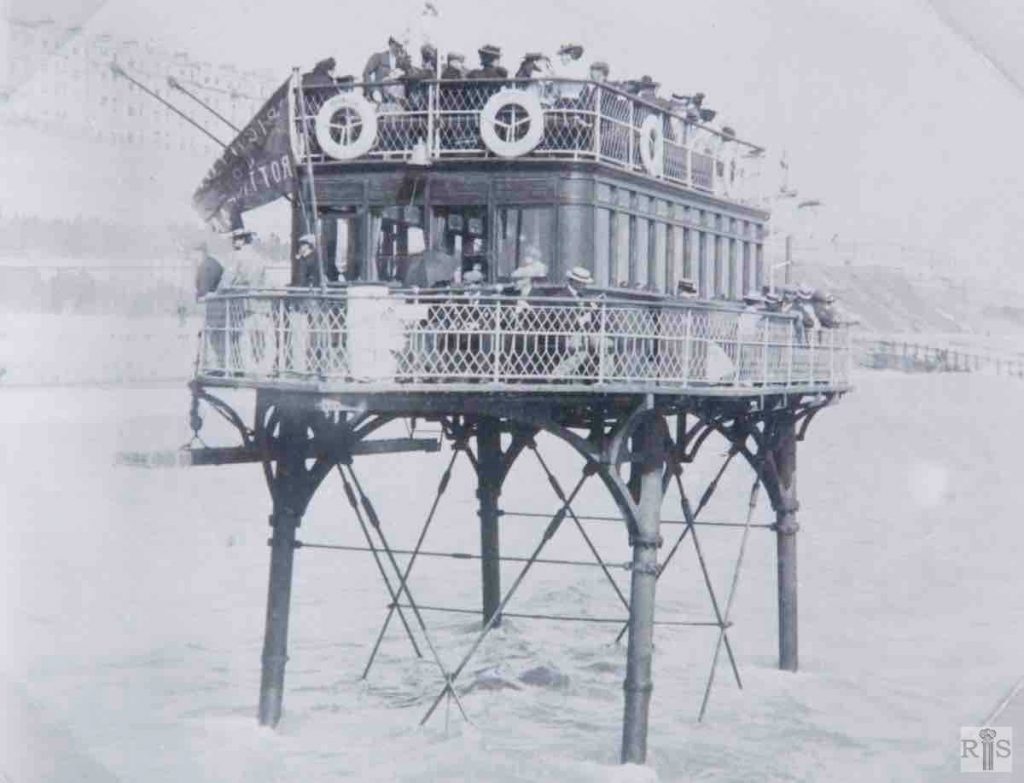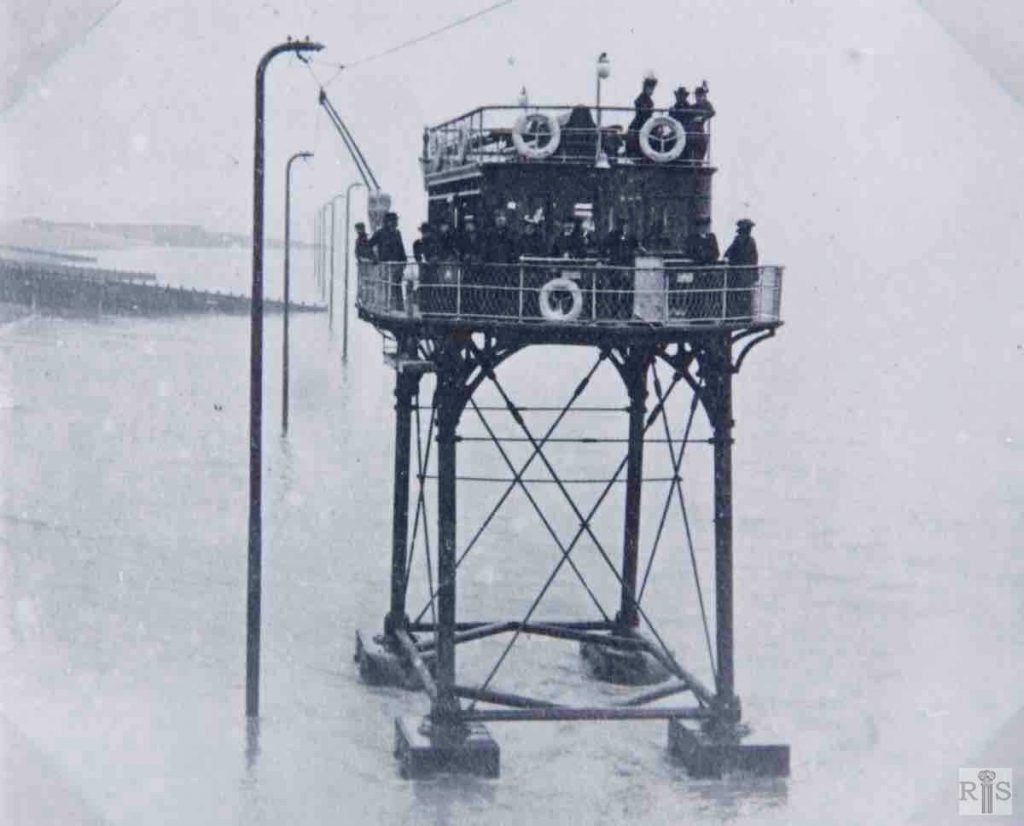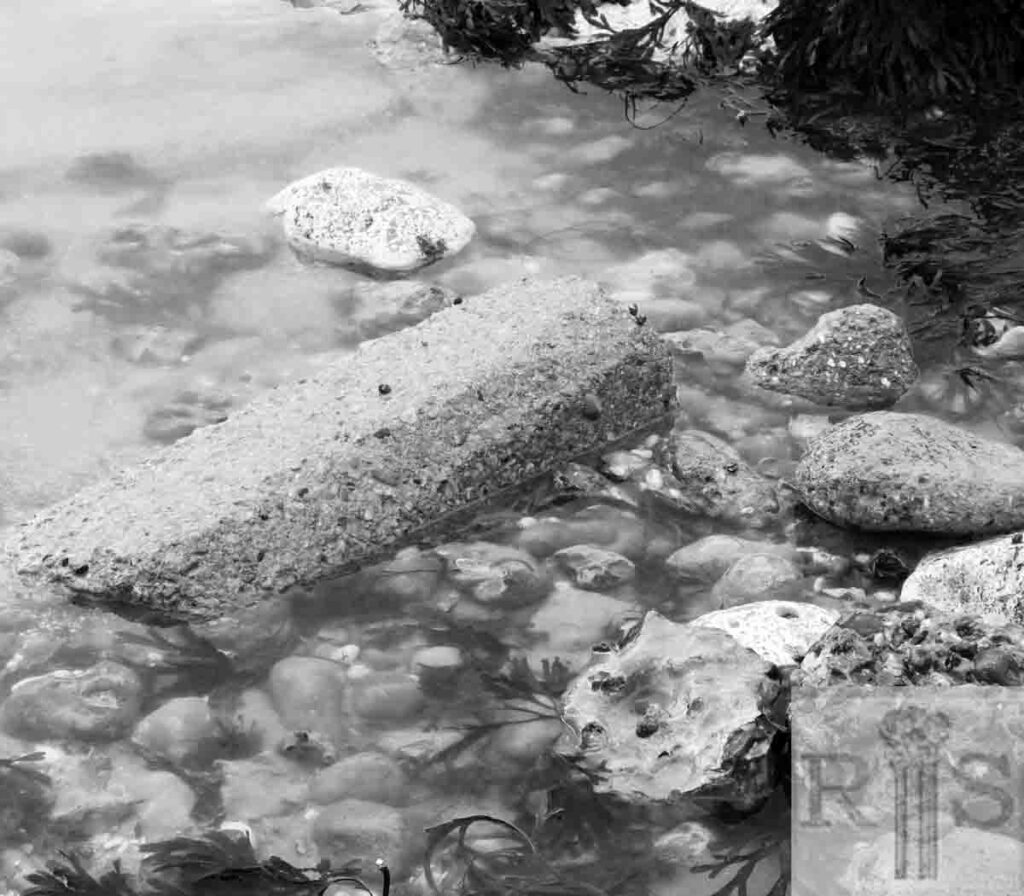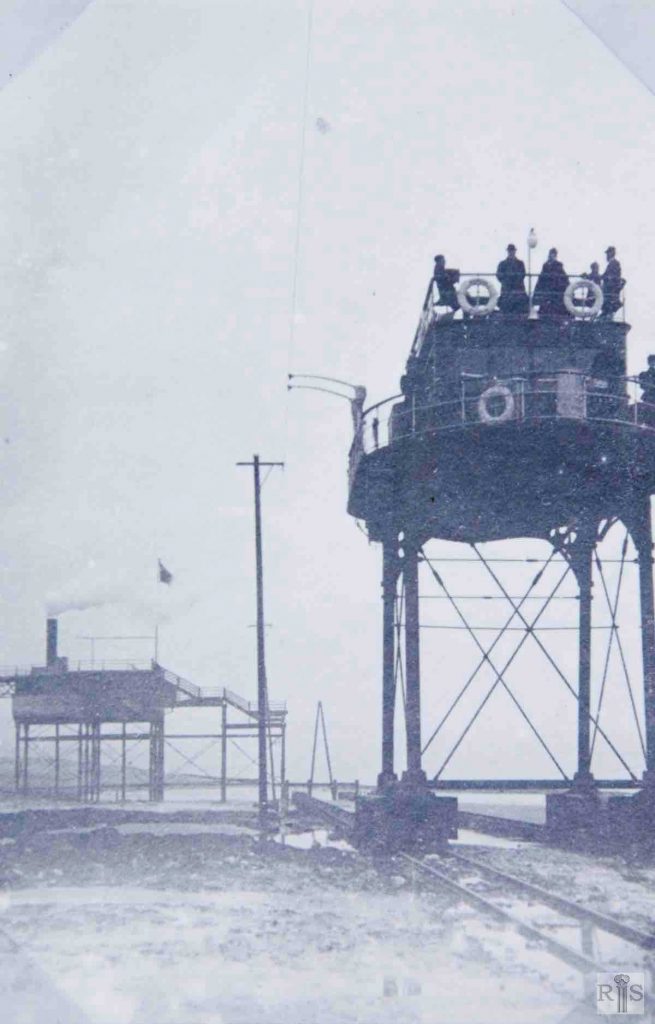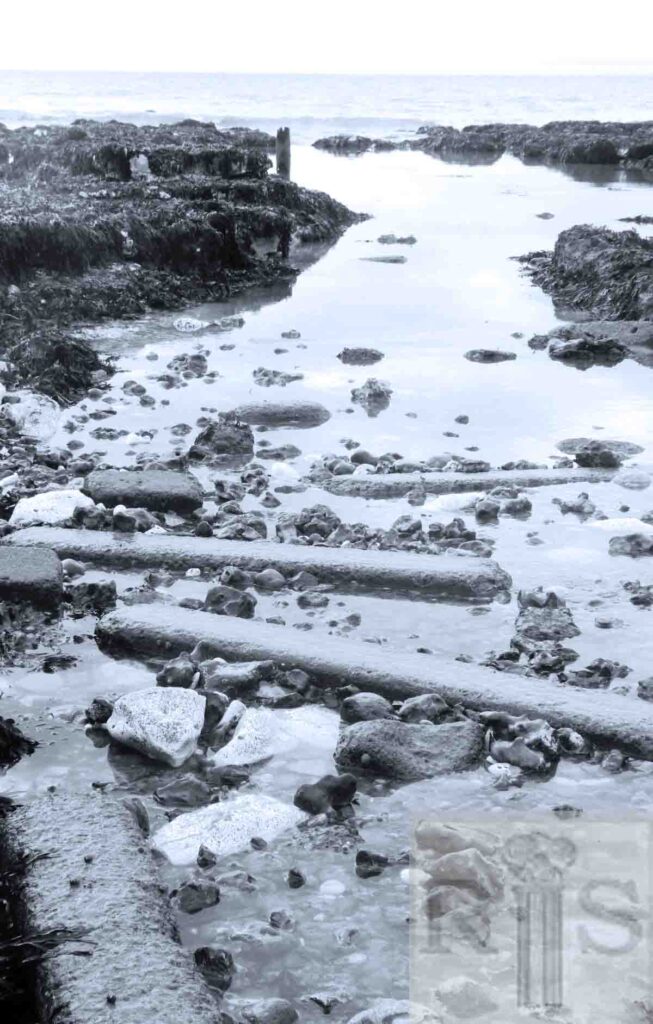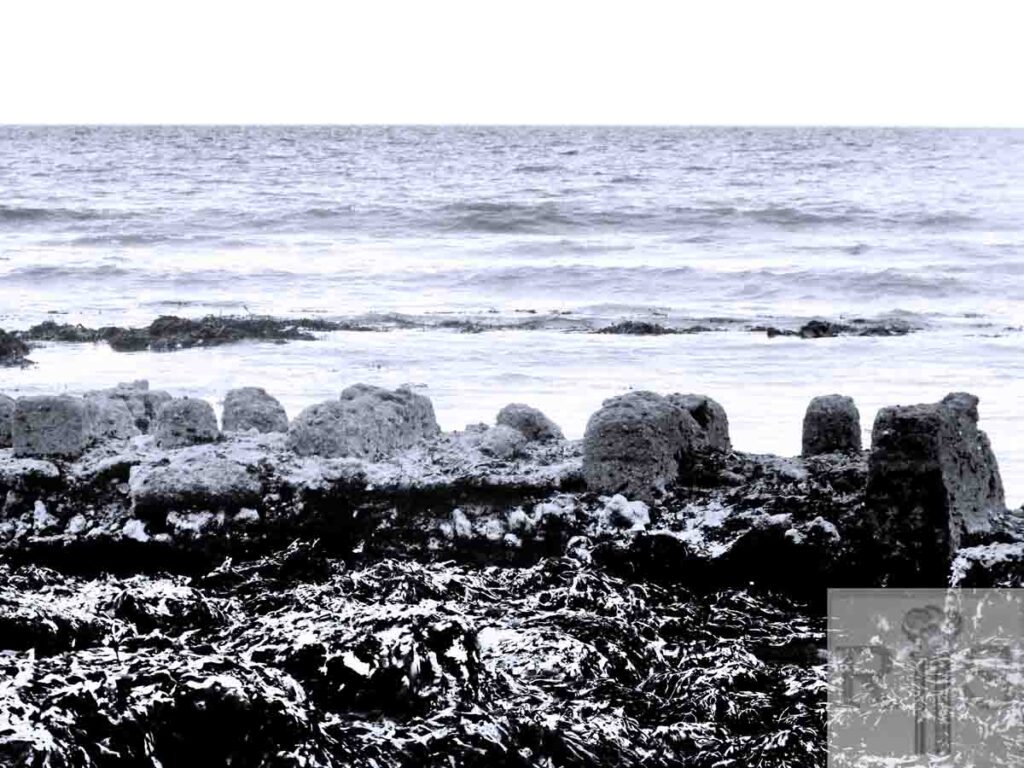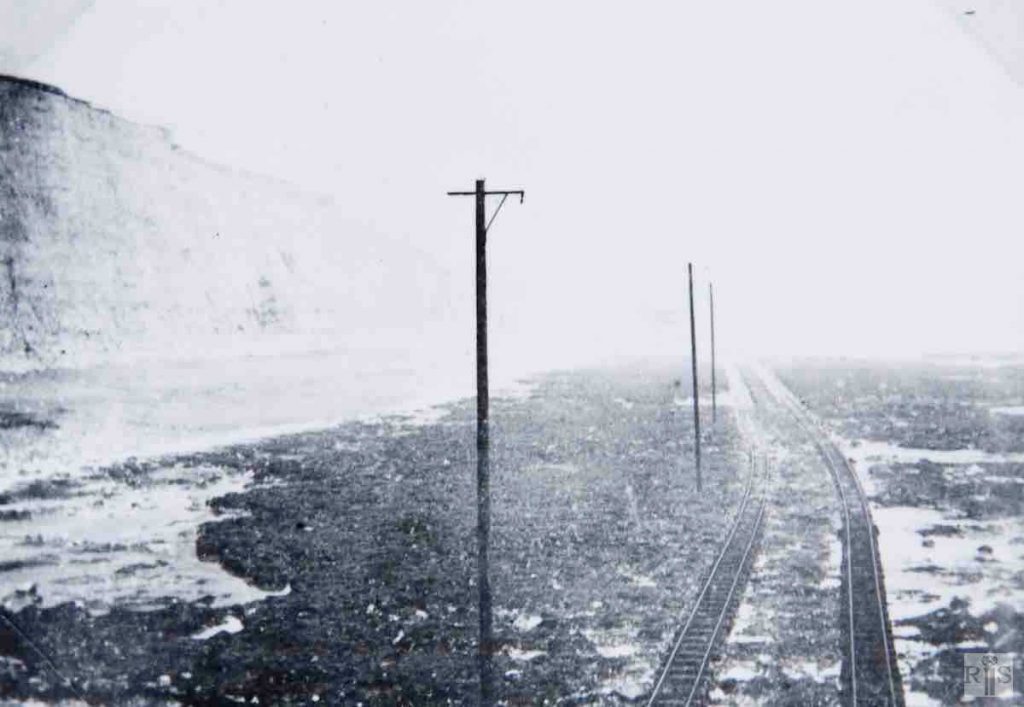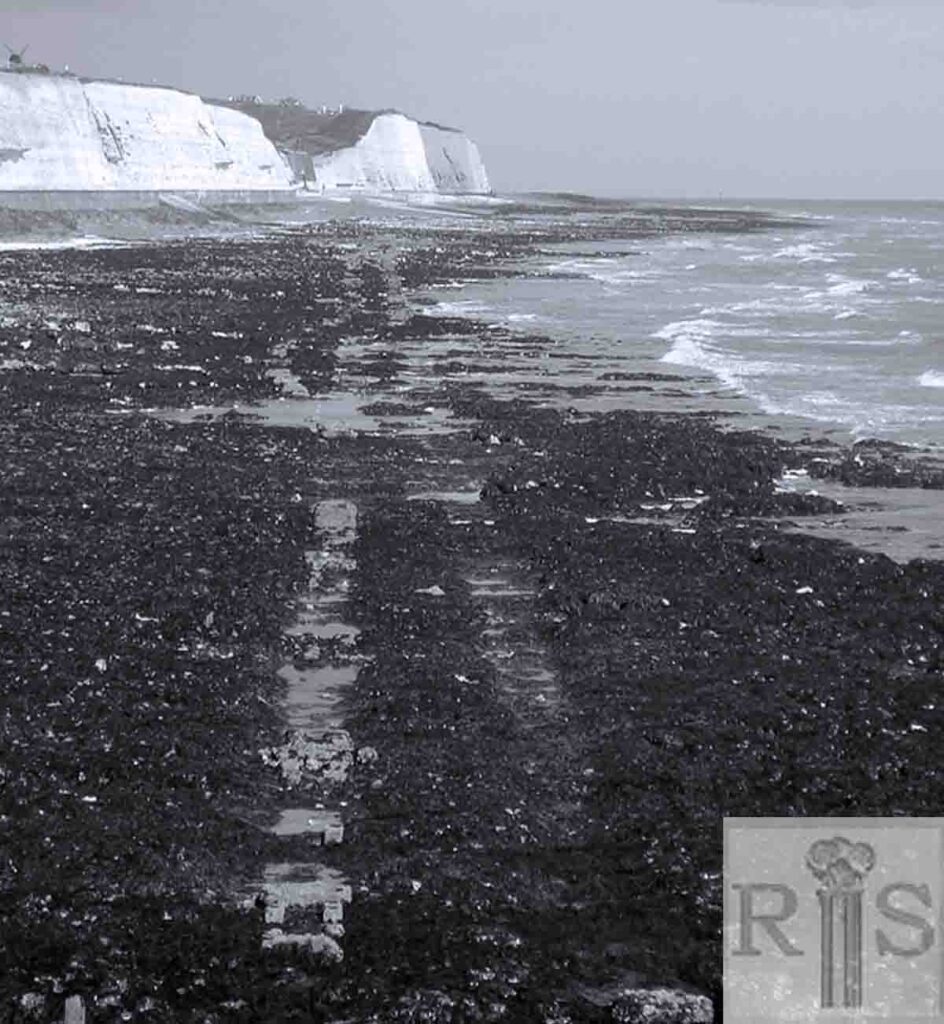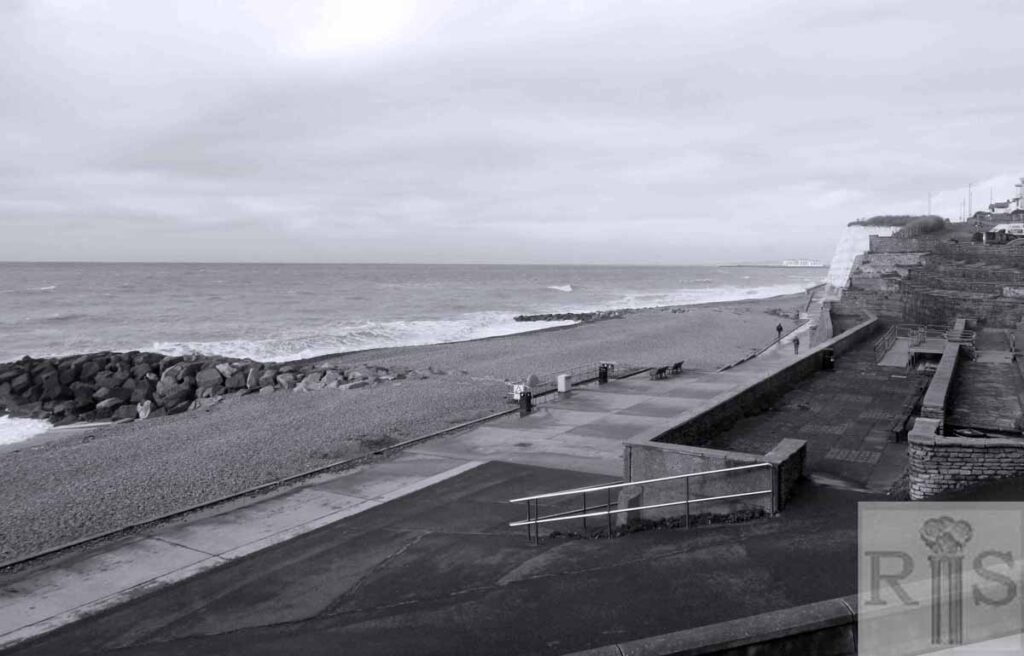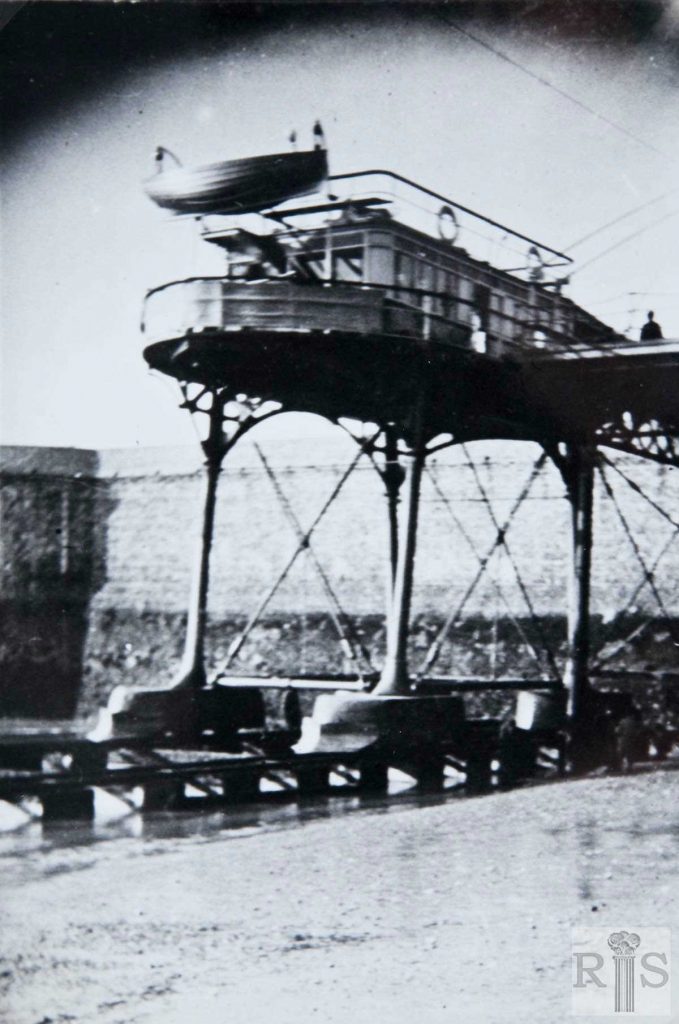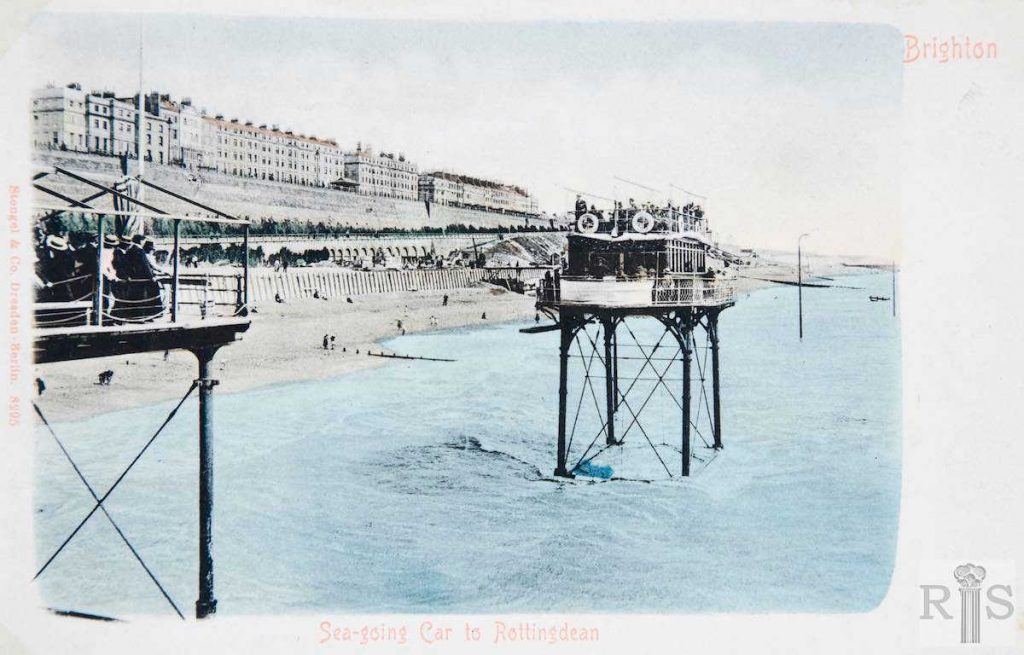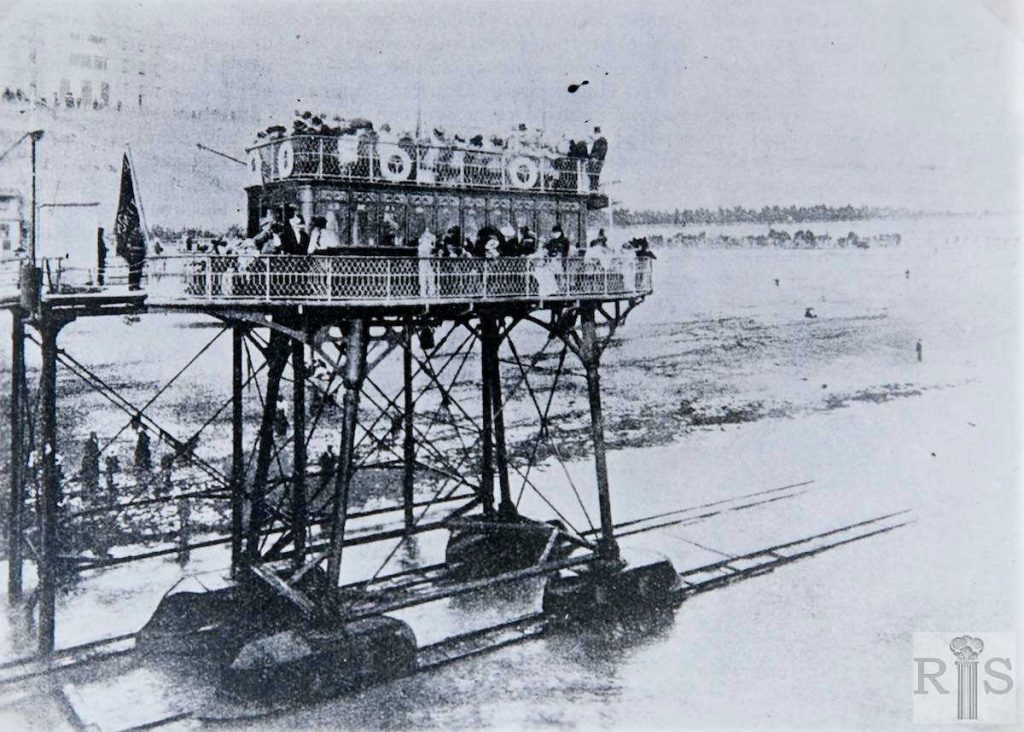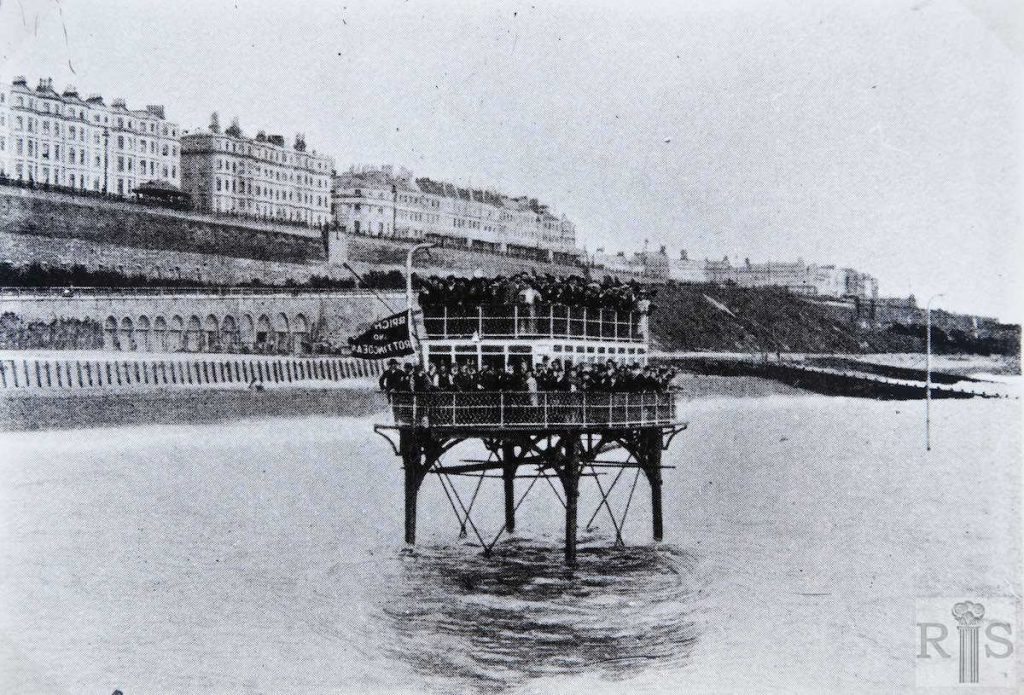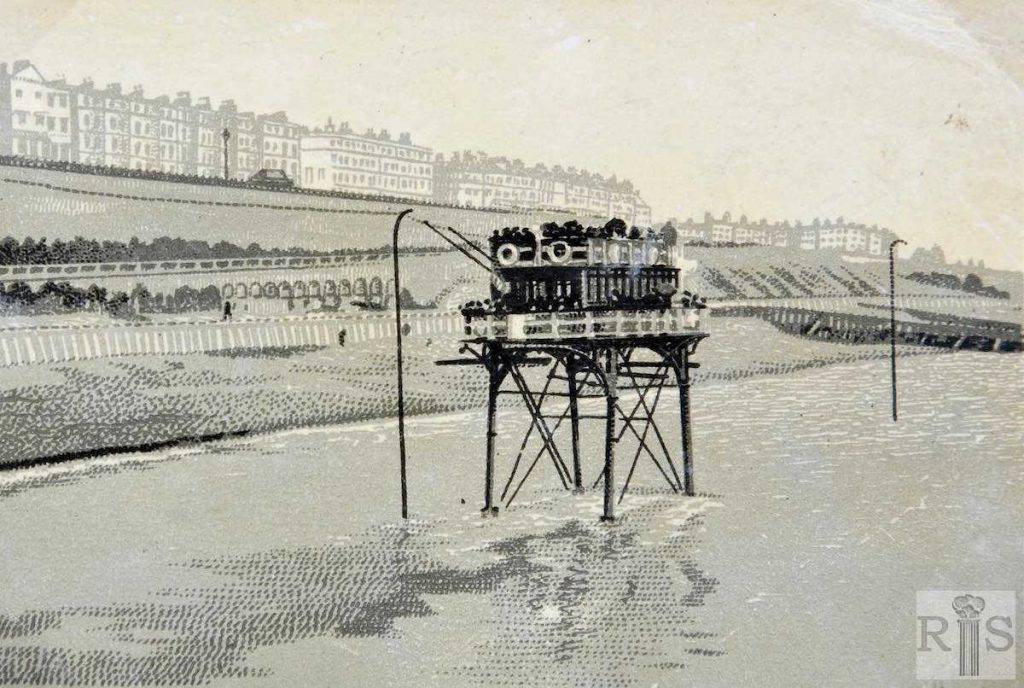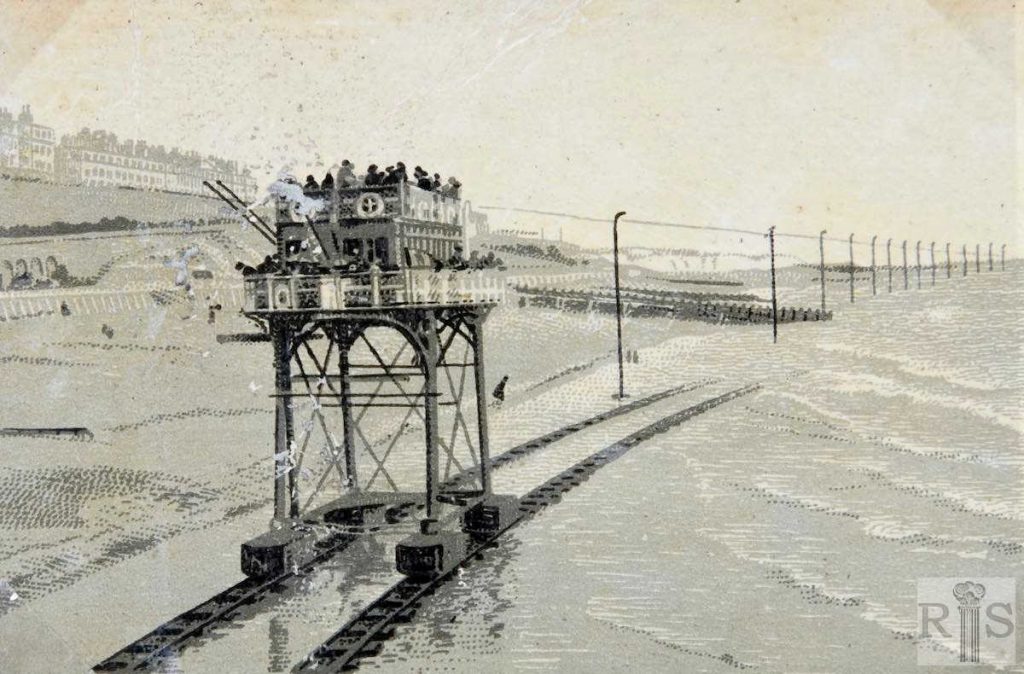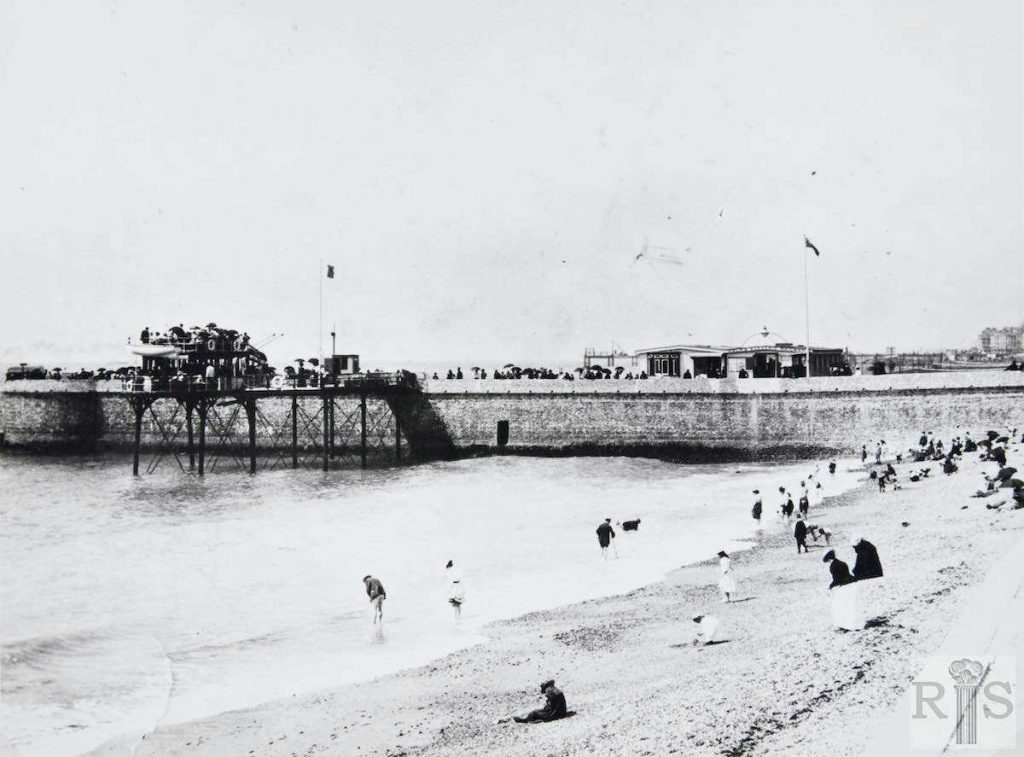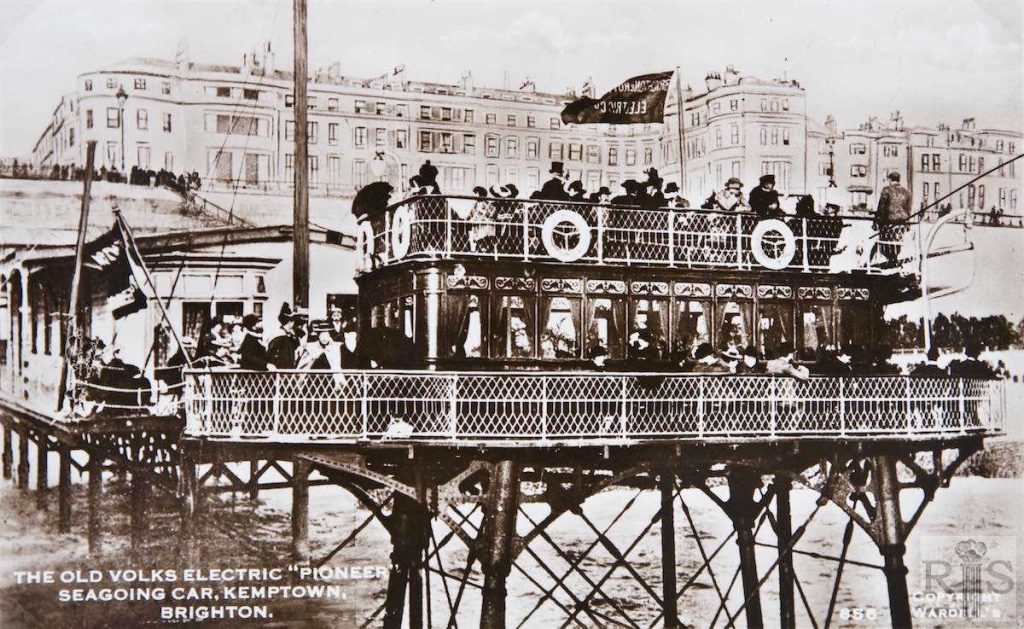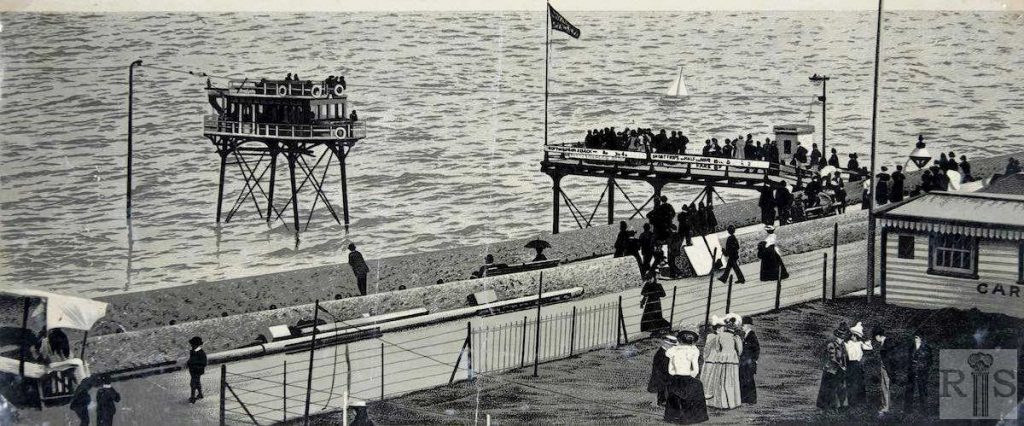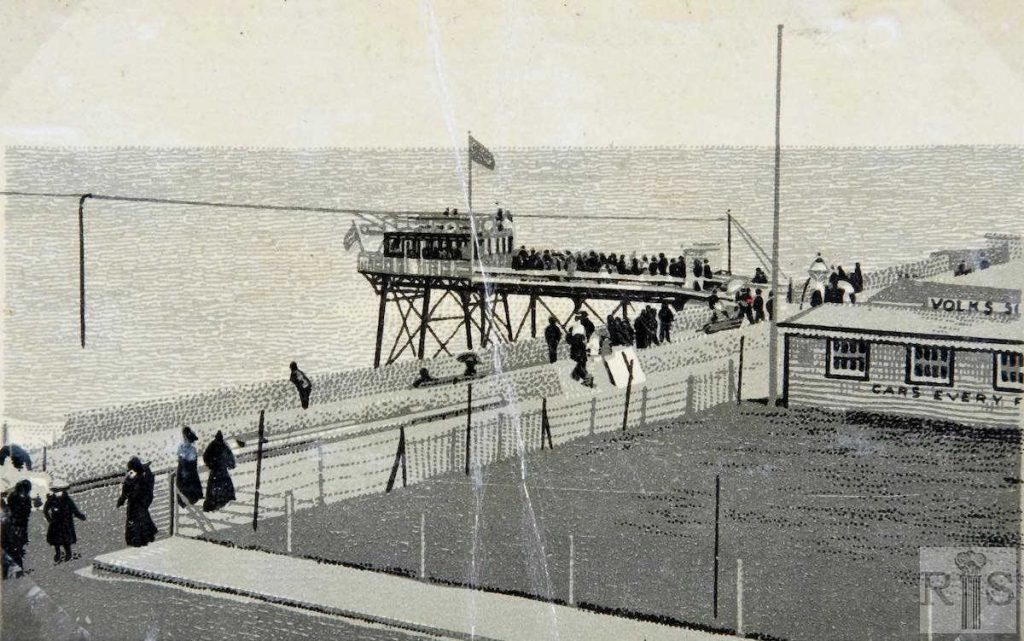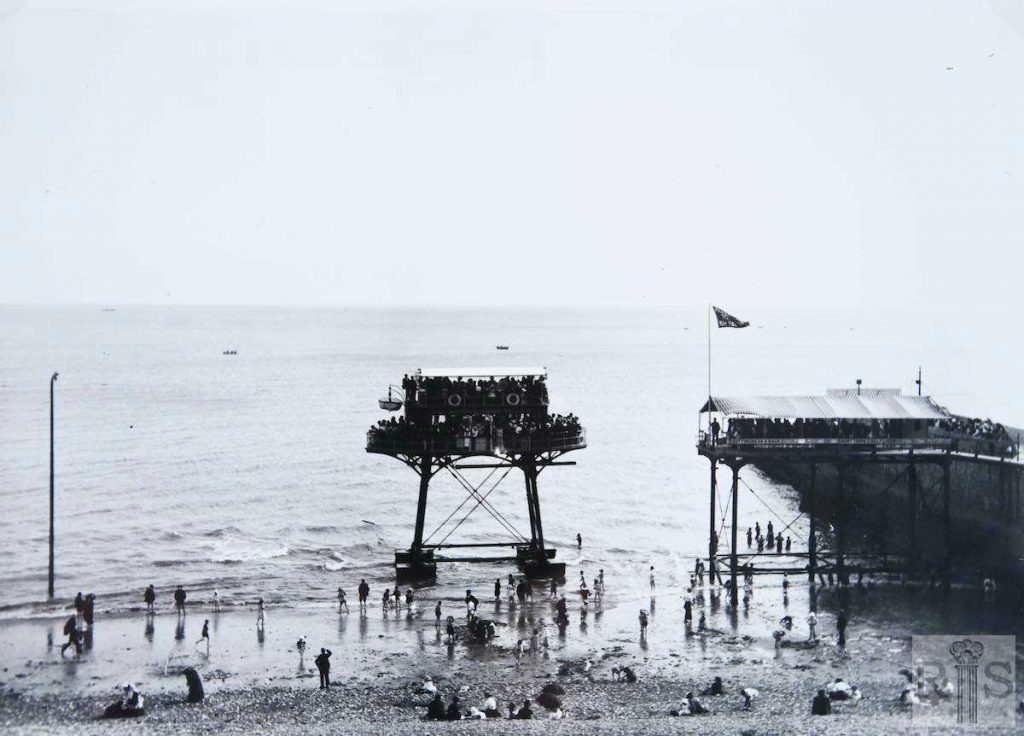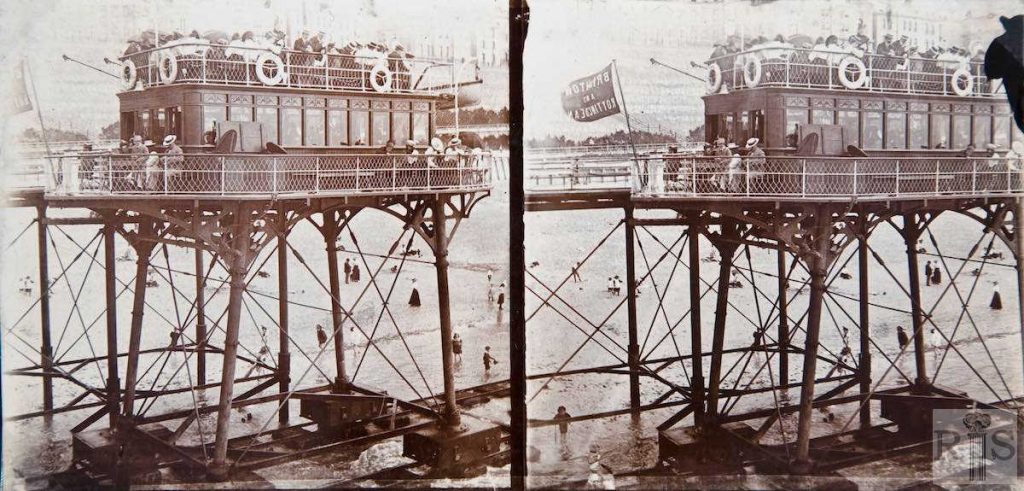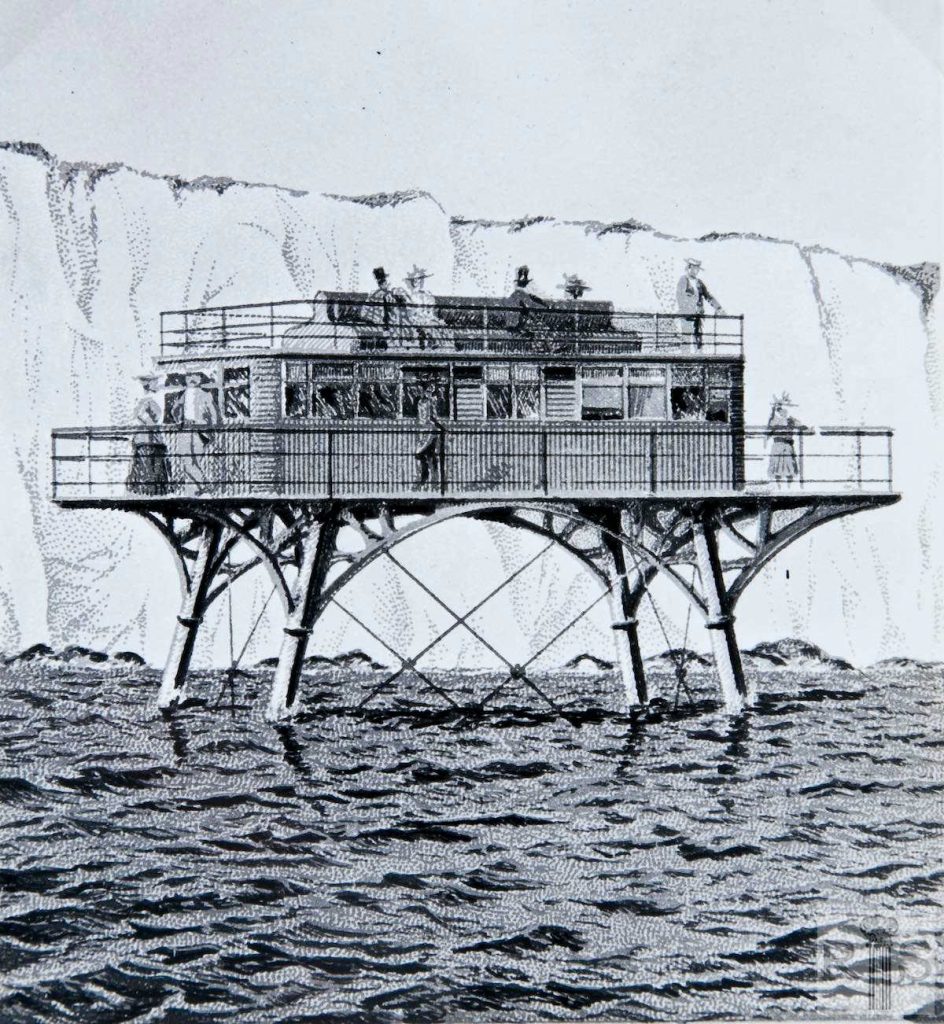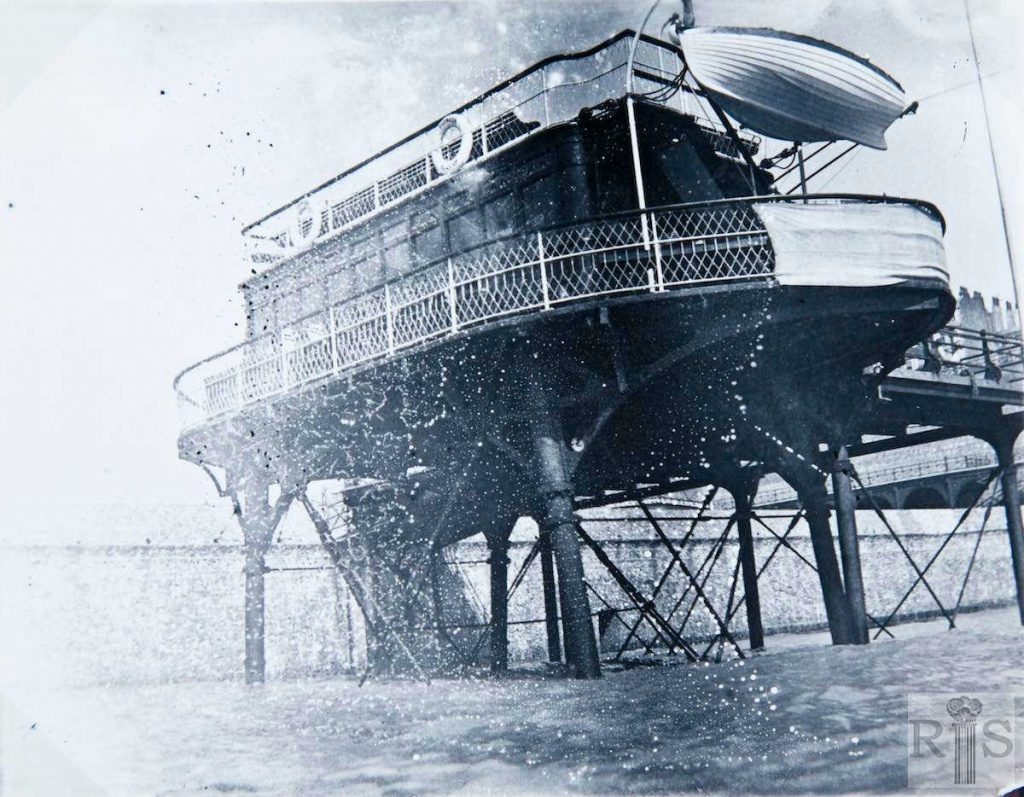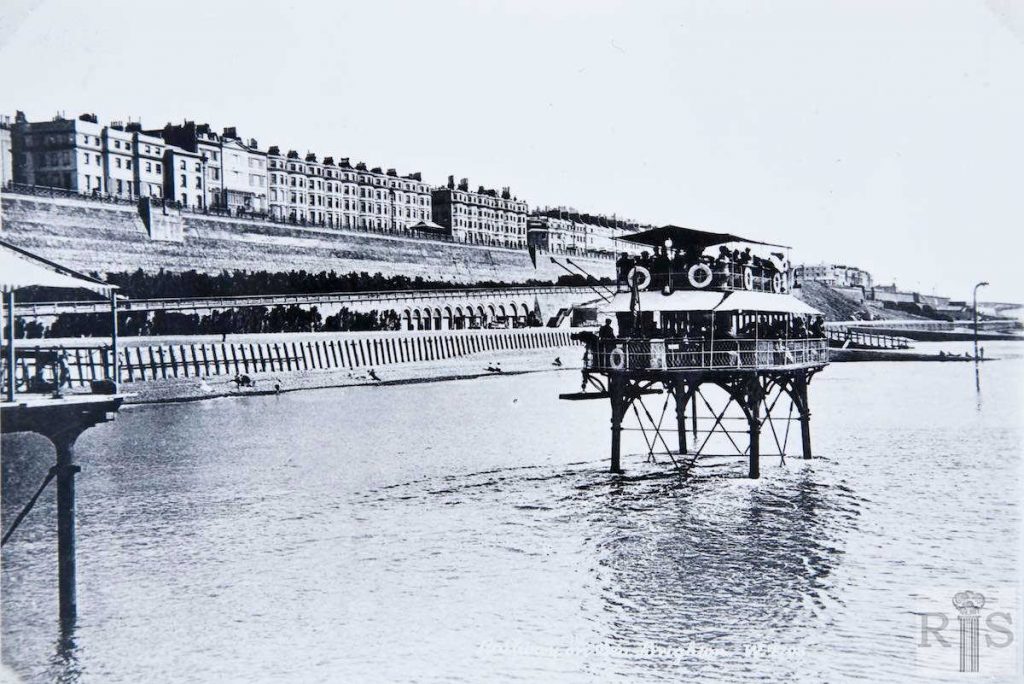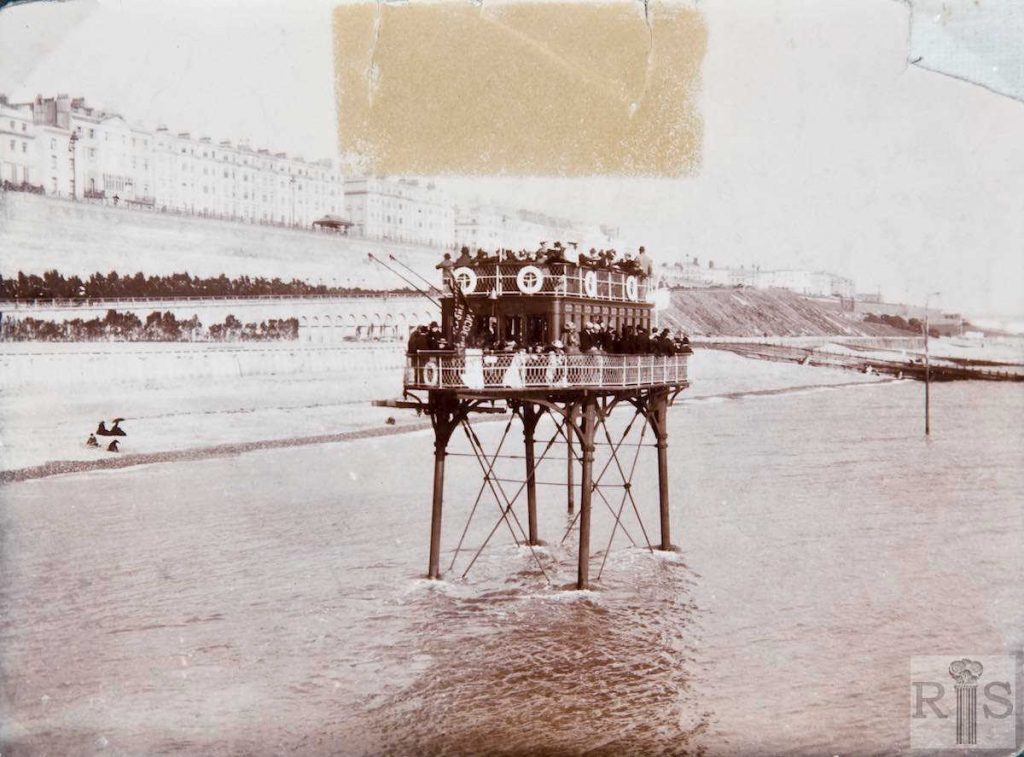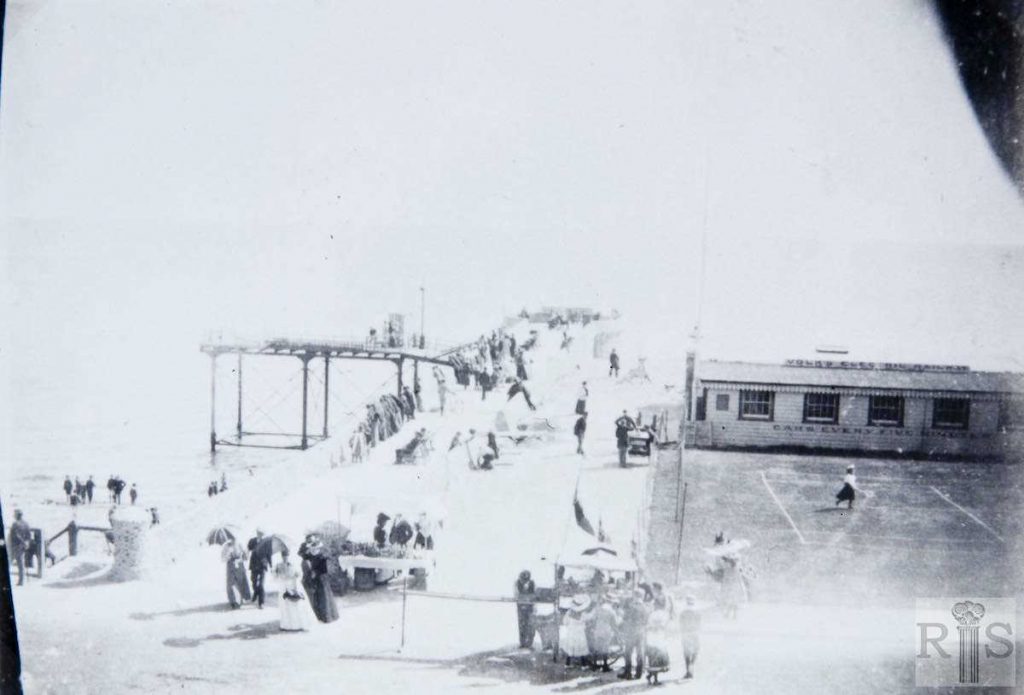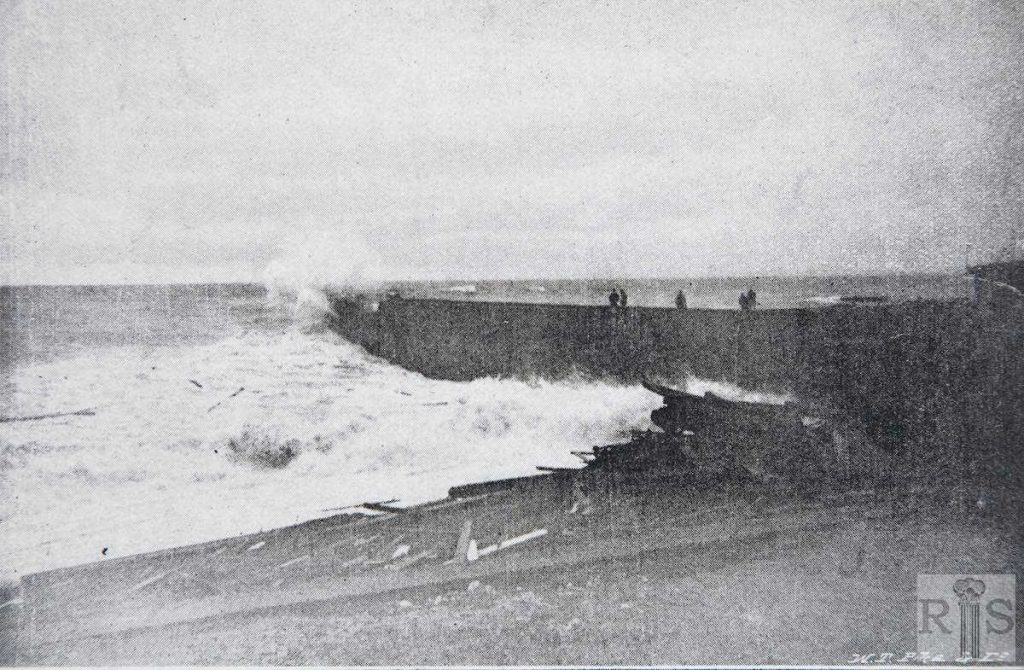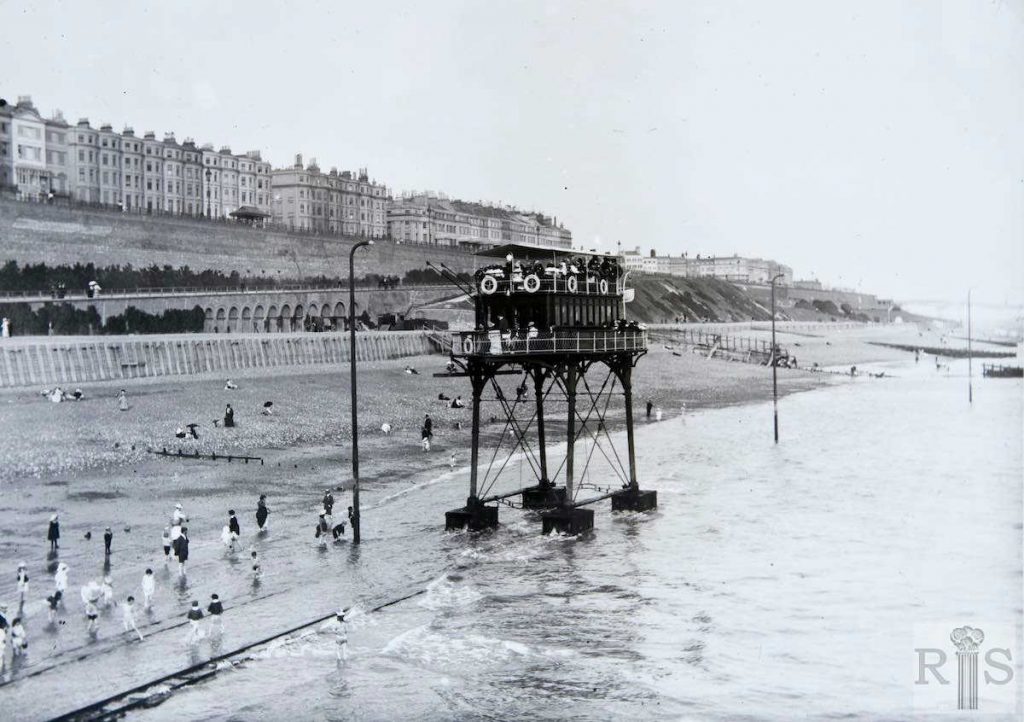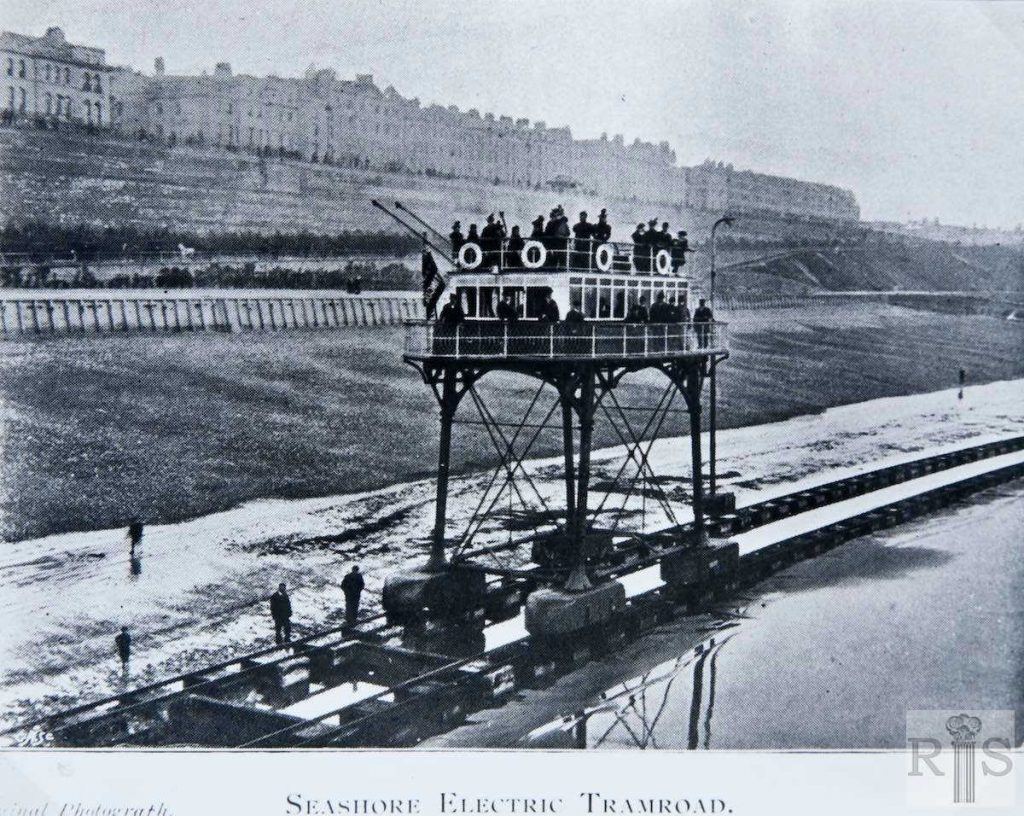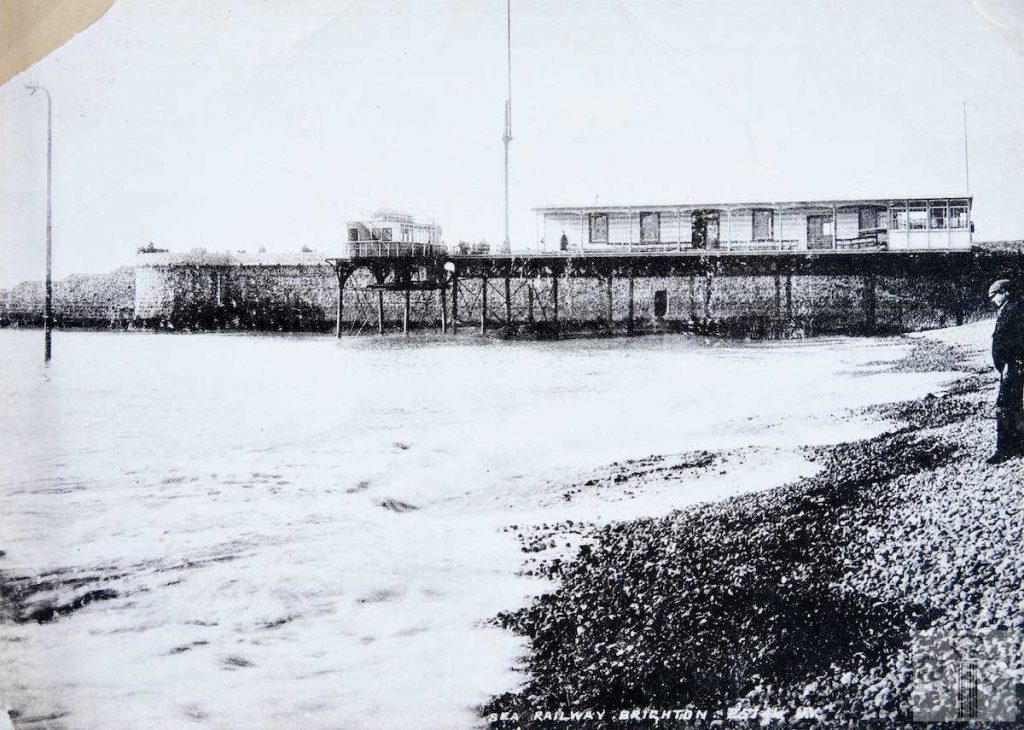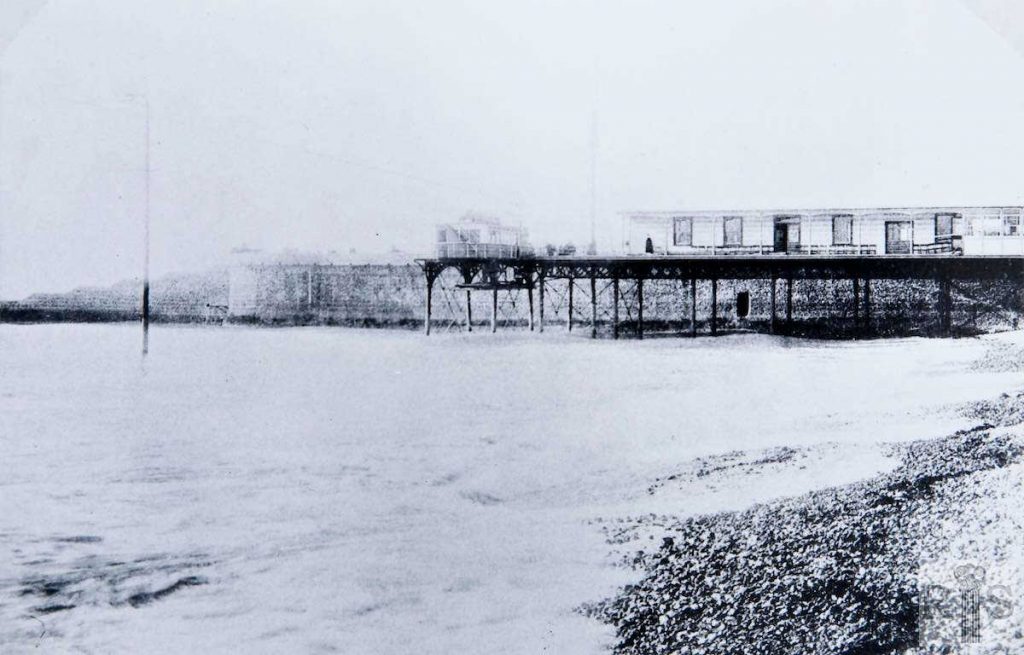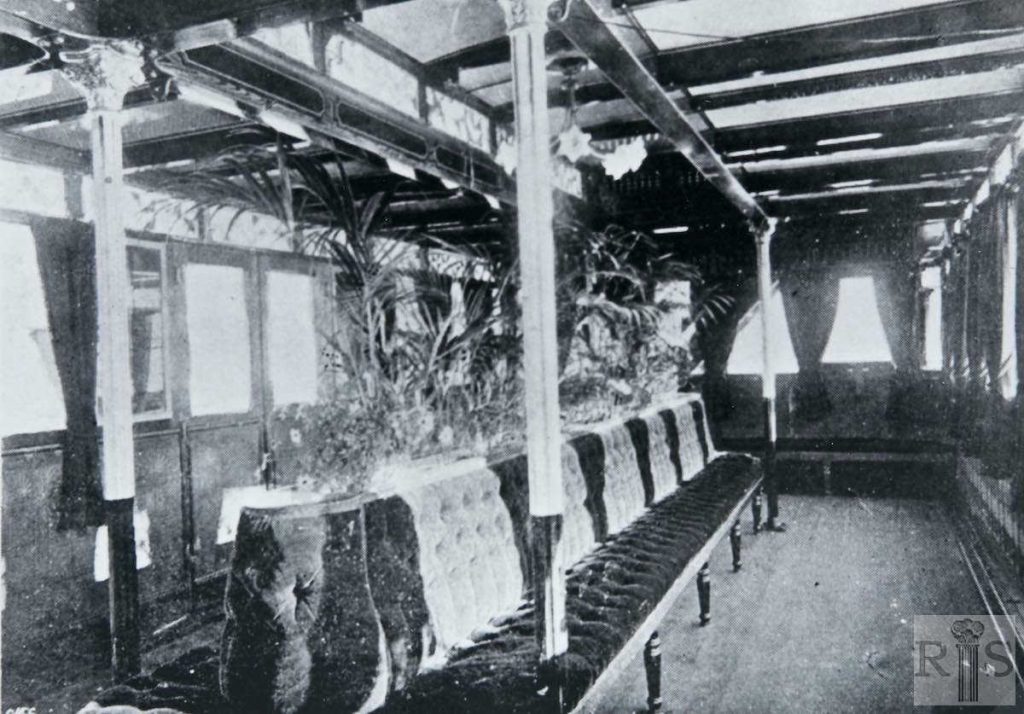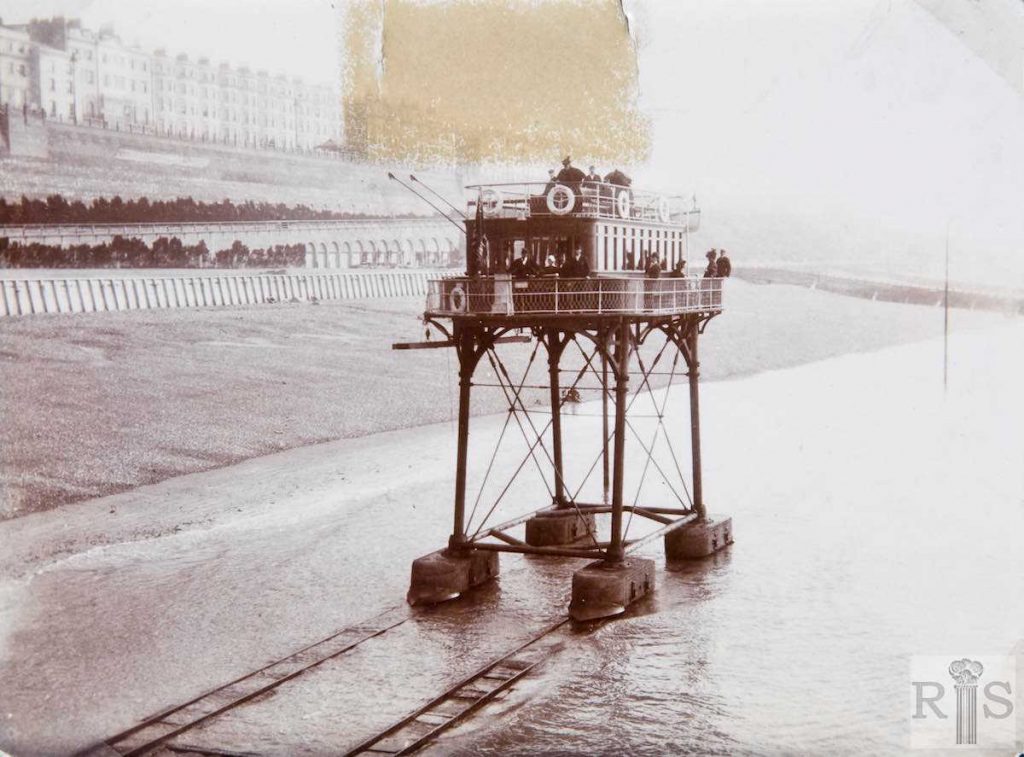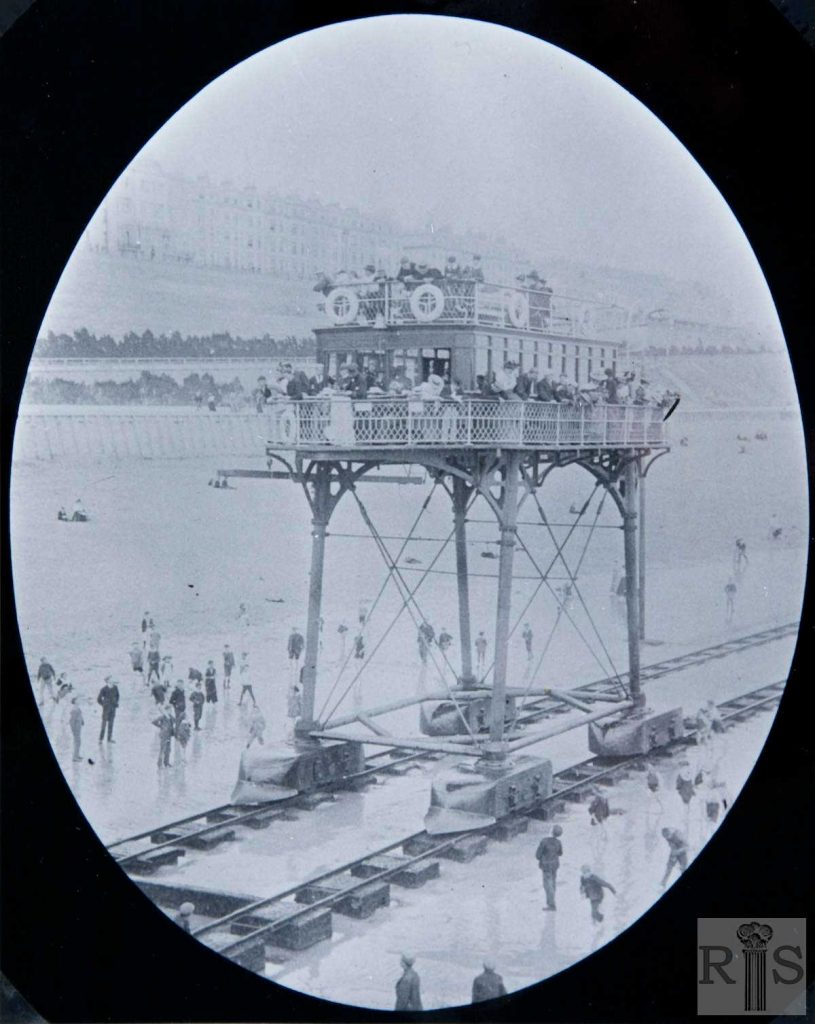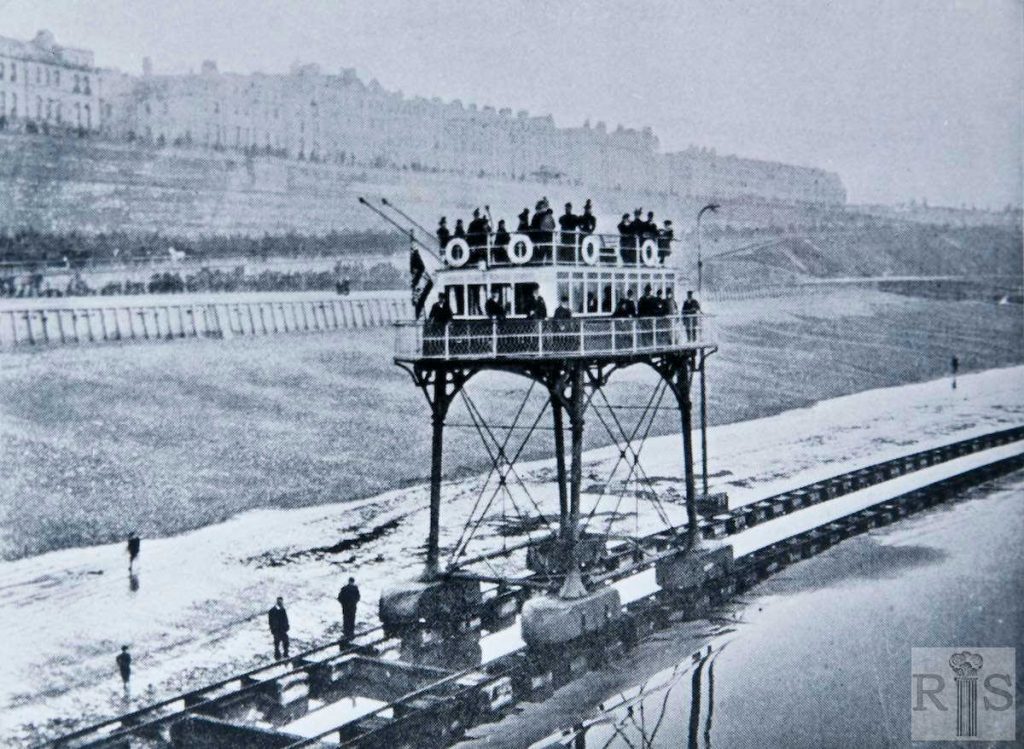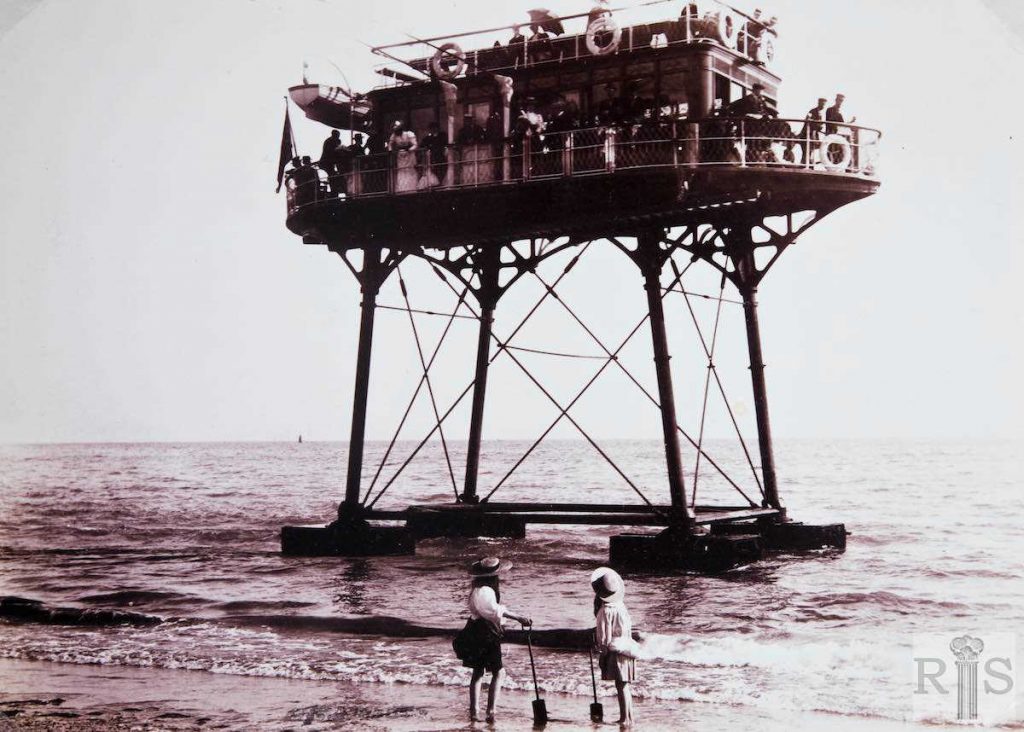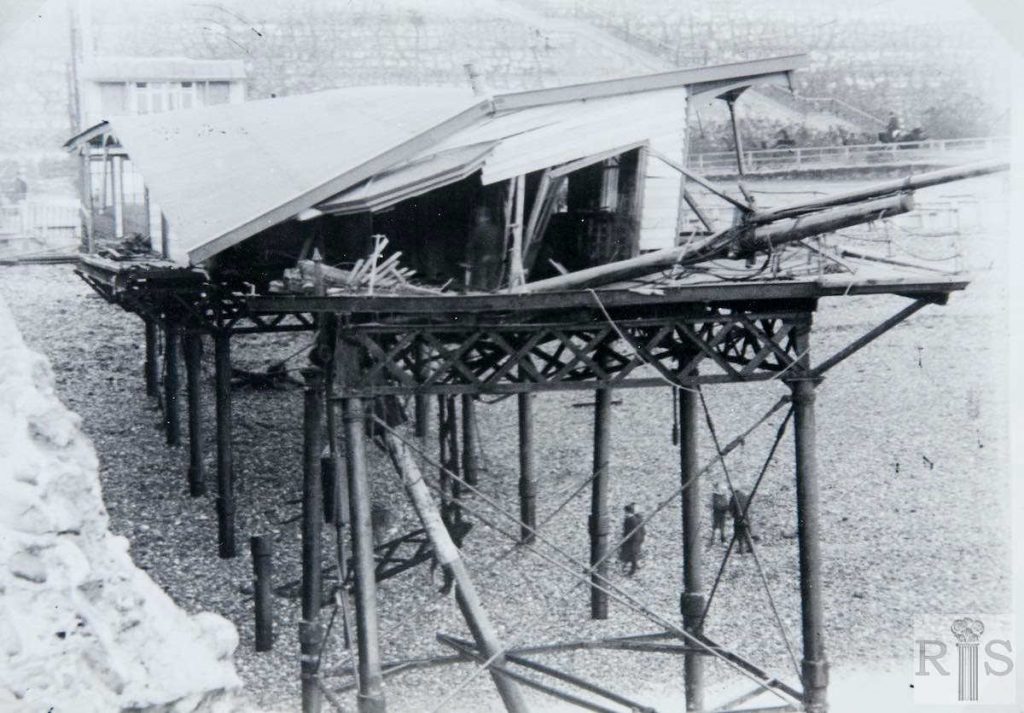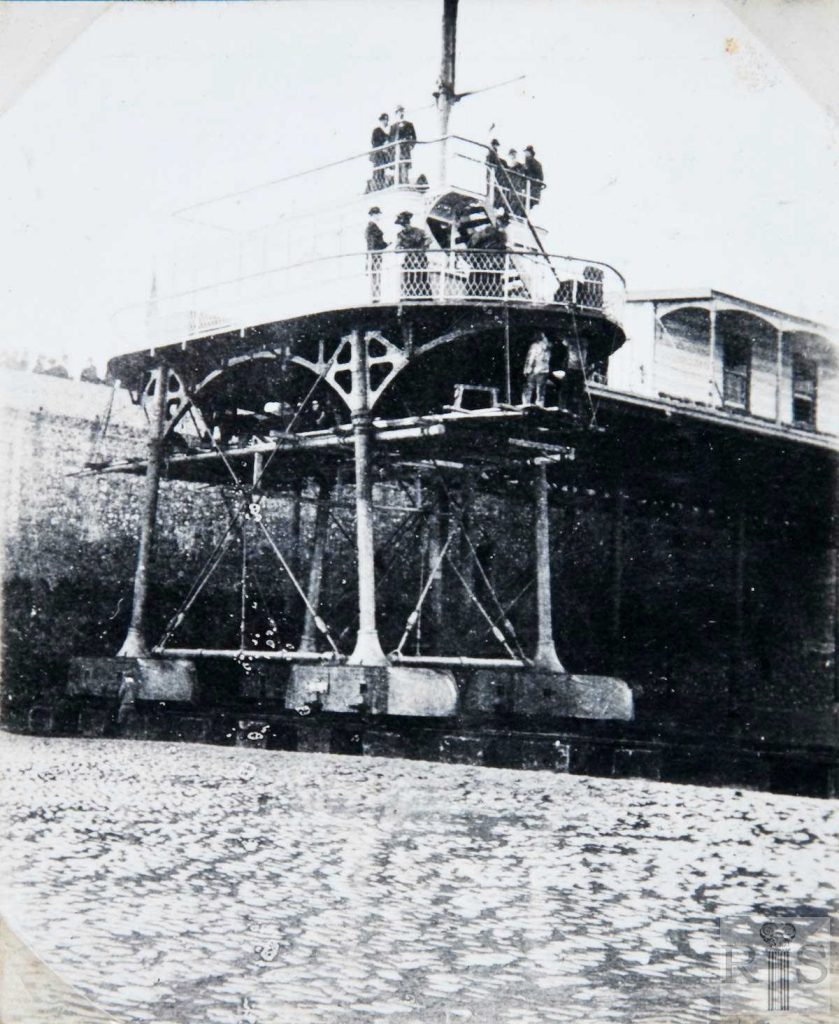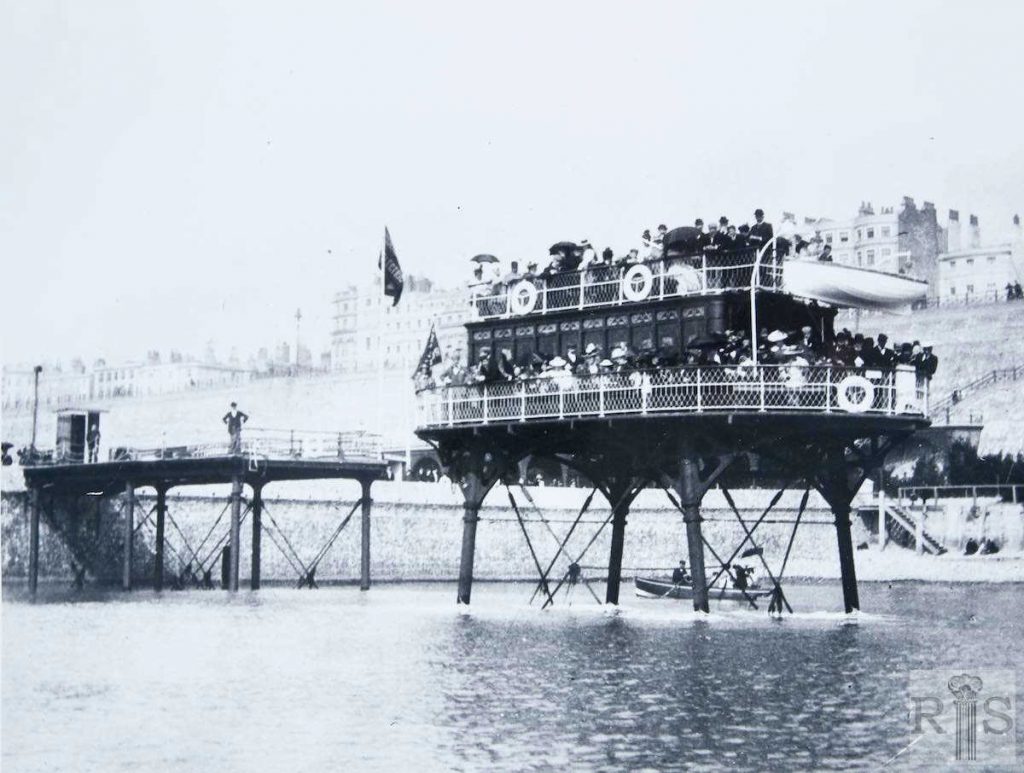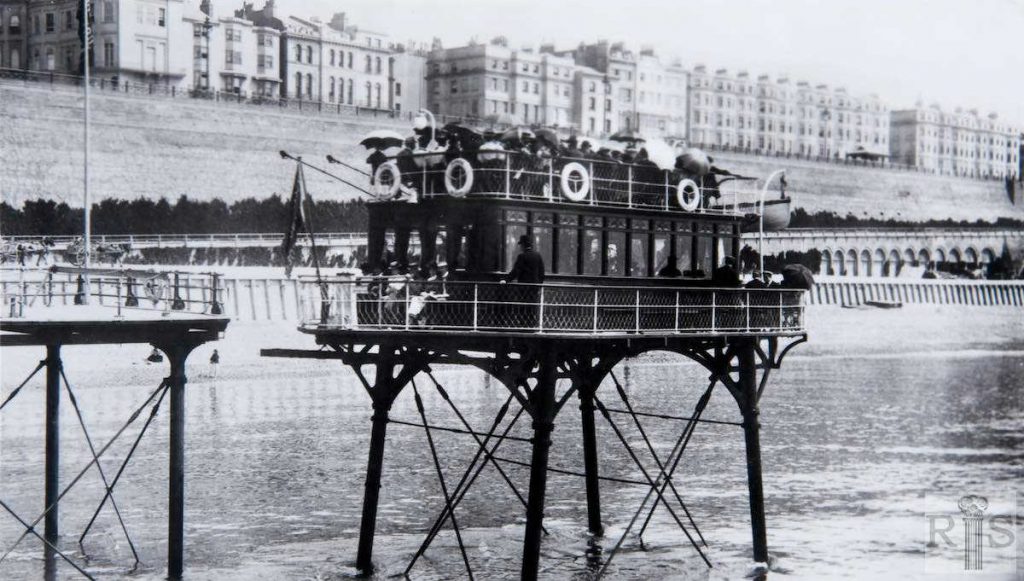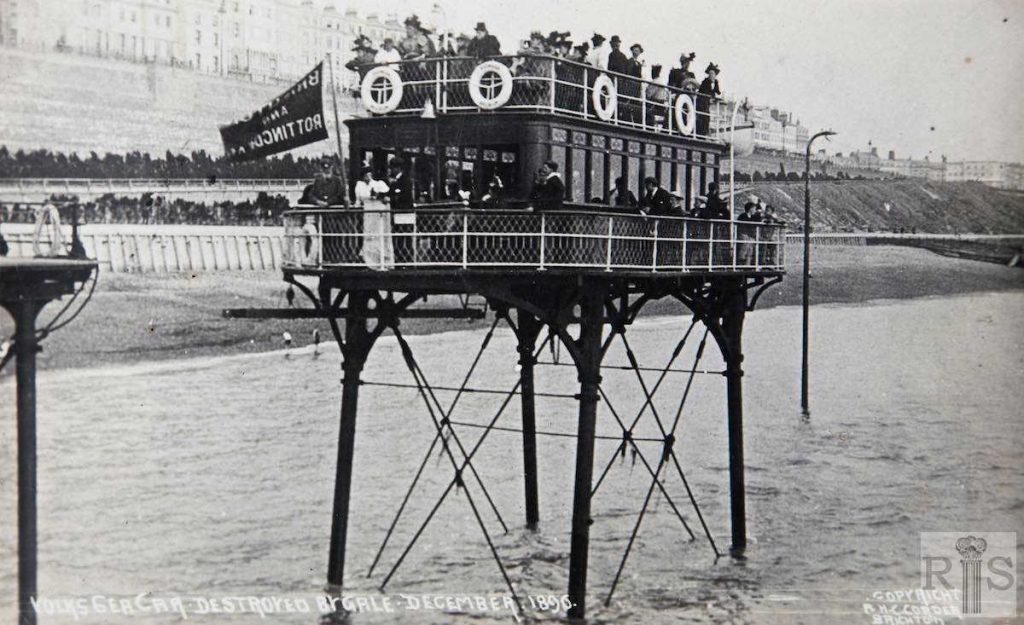Brighton East Seafront: images on the beach (B)
Brighton and Rottingdean Seashore Electric Railway (Daddy Long Legs)
James Gray: I cannot say with any conviction whether this photograph was taken before or after the brief active life of the tramway (1896-1901). There is no sign of the generator or of the overhead wires, and the condition of the rails suggests that they had been in position for some time, so I think it dates from soon after the closure in 1901. jgc_32_046
2019: The structure in the centre of the original image is the landing stage for Brighton and Rottingdean Seashore Electric Railway which ran along the shore from Paston Place to Rottingdean. (Photographer: Ron Fitton)
James Gray: As with [jgc_32_046] the previous photograph, I cannot be sure of the year in which this was taken. There is no sign of the generator, no sign of overhead wires and the high tide conceals the rails, if in fact they were there. My guess is that the photograph dates from not long after the closure of the Tramway in 1901. jgc_32_047
James Gray: The photographs on the left need no explanation, except to correct the title of the Electric Railway to the Brighton and Rottingdean Seashore Electric Tramroad. jgc_06_094
James Gray: Five interesting photos [jgc_32_049 to 053] during the short life of the Railroad, in four of which passengers are seen. A pity they are so indistinct as more clarity would have been revealed the mechanics of the operation. jgc_32_049
James Gray: [See caption for jgc_32_049 above.] jgc_32_050
2019: The ‘Daddy Long Legs’ or more correctly Brighton and Rottingdean Seashore Electric Railway ran along the shore from Paston Place to Rottingdean and was the brainchild of Magnus Volk. Construction took two years from 1894 to 1896 and the railway officially opened on 28 November 1896, but it was nearly destroyed by a storm the night of 4 December. Volk immediately set to rebuilding the railway and it reopened in July 1897.
James Gray: More photographs of the pier at the end of the Marine Electric Railway. jgc_32_054
2019: The landing stage for the electric railway stood where the stone breakwater stands today. The area known as Rottingdean Gap was altered again by the building of the Undercliff Walk and the Rottingdean Terraces in the 1930s. (Photographer: Ron Fitton)
James Gray: Three views [jgc_06_142, 143 and 144] of the marine electric car, or ‘Daddy Long Legs’ as it was more familiarly known, at the Paston Place Terminus. An ambitious project of Magnus Volk, it ran for a distance of 2¾ miles to Rottingdean. The lines were 100 yards from Madeira Drive and at high tide the car moved through 15 feet of water. It was opened in September 1896 but was discontinued in 1901. jgc_06_142
James Gray: [See caption for jgc_06_142 above.] jgc_06_143
James Gray: [See caption for jgc_06_142 above.] jgc_06_144
James Gray: Despite the rather garish and artificial appearance of these prints they nevertheless give a good impression of the sea-going car and of the Paston Place Terminus. jgc_06_151
James Gray: Sea-going car with the tide in. Note the barren appearance of the Kemp Town slopes. jgc_06_149
James Gray: [See caption for jgc_06_151 above.] jgc_06_153
James Gray: Copies of photographs attributed to Mr A H Fry. They show the sea-going car at the Terminus east of the Banjo Groyne. At the other side of the groyne was the Paston Place Station of Volk’s Railway and passengers for Rottingdean changed here. Note the skeleton of the Palace Pier beyond. jgc_06_145
James Gray: [See caption for jgc_06_145 above.] jgc_06_146
James Gray: More photographs of the sea-going car at the Paston Place Terminus, by the Banjo Groyne. Note the barren appearance of the Kemp Town slopes. jgc_06_147
James Gray: [See caption for jgc_06_147 above.] jgc_06_148
James Gray: Despite the rather garish and artificial appearance of these prints they nevertheless give a good impression of the sea going car and of the Paston Place Terminus. jgc_06_150
James Gray: [See caption for jgc_06_150 above.] jgc_06_152
James Gray: Two interesting photographs, [see also jgc_06_155] believed to date from 1900. This one gives an excellent view of the loading platform at the Banjo Groyne Terminus. jgc_06_154
James Gray: A stereoscopic view. jgc_06_158
James Gray: Three photographs [see also jgc_06_160 and 162] of the Paston Place Terminus. jgc_06_161
James Gray: Taken from a T Donovan photograph. jgc_06_159
James Gray: No comment. jgc_06_163
James Gray: No comment. jgc_06_165
James Gray: Three photographs of the Paston Place Terminus [see also jgc_06_160 and 161]. This view, almost certainly taken in 1896, because the landing platform was under construction. Incidentally, this is the only photograph I have seen showing the tennis court adjoining Volk’s Railway Station. jgc_06_162
James Gray: Two interesting photographs, [see also jgc_06_154] believed to date from 1900. jgc_06_155
James Gray: More photographs of this unique railway. jgc_06_156
James Gray: Three photographs [see also jgc_06_161 and 162] of the Paston Place Terminus. jgc_06_160
James Gray: [Middle right] No comment. jgc_06_164
James Gray: [Bottom left] A view of the interior of the saloon car, quite a rarity. jgc_06_157
James Gray: Two of these [see also jgc_06_175] were copies from lithographs of original photographs by T Donovan. The car was not destroyed in the storm of December 1896. It was damaged but survived until 1901. Additional Information: Rottingdean jetty and submarine rail. jgc_06_177
James Gray: No comment. jgc_06_166
James Gray: This photograph was taken in August 1898. jgc_06_167
James Gray: [Date unknown.] Another view. jgc_06_169
James Gray: Sea-going car which formerly ran between the Banjo Groyne and Rottingdean. jgc_06_176
James Gray: [Bottom right.] Two of these were copies from lithographs [see also jgc_06_177] of original photographs by T Donovan. The car was not destroyed in the storm of December 1896. It was damaged but survived until 1901. jgc_06_175
James Gray: Three more photographs [see also jgc_06_179 and 180] of the sea-going car. jgc_06_178
James Gray: The car approaching the Paston Place Terminus, with a good view of the line poles supporting the overhead wire. jgc_06_168
James Gray: Another photograph showing the damaged Paston Place Terminus after the storm of December 1896. jgc_06_172
James Gray: Another view of the car at the Paston Place station. jgc_06_173
James Gray: The sea-going car of the Brighton and Rottingdean Seashore Electric Tramroad, fully laden, near the Banjo Groyne Terminus. Year unknown. jgc_06_174
James Gray: Another view of Volk’s sea-going car. Additional Information: Postcard sent to Mrs Perry in New England Road, Haywards Heath from her son, wishing her a Happy Birthday. jgc_06_180
James Gray: Postcard of the sea-going car. jgc_06_179
